
REU People
-
REU Team
-

Lindsay Gouedy
LA-SiGMA Outreach/Assessment Coordinator at LA Tech
P.O. Box 10198 T.S.
Reese Hall 125
Louisiana Tech University
Ruston, LA 71272
Phone: (318) 245-8694
lgouedy@latech.edu
Lindsay Gouedy, a 2009 graduate of Louisiana Tech University with a Bachelor's of Science in Agricultural Economics, has joined the LaSIGMA family. Mrs. Gouedy brings with her five years of experience as an Environmental Education Consultant. Over the past five years she has served as contractor to the Sparta Groundwater Commission, developing and correlating environmental education curriculum, coordinating education events for students and adults, and coordinating fundraising events. Mrs. Gouedy has also successfully completed similar contracts with Louisiana Farm Bureau's Ag in the Classroom and Louisiana Department of Ag and Forestry. She currently resides in Ruston, LA with her husband Joe and two beautiful boys.
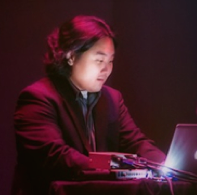
Danny Holmes
REU Coordinator
Center for Computation & Technology
Louisiana State University
dholm13 AT tigers.lsu.edu
Danny Holmes is a composer, sound artist, researcher, software developer, and music educator. Danny holds degrees in classical guitar and electronic music composition, and he is currently pursuing a PhD in Experimental Music and Digital Media at Louisiana State University. He has recently presented work at conferences for TMEA, SEAMUS, and ICMC. Danny's interests and major research areas include mobile music, gesture and performance, and music technology in education.

Bety Rodriguez-Milla
LONI Institute/LA -SiGMA Scientific Coordinator
Center for Computation & Technology
Louisiana State University
brodrig AT cct.lsu.edu
http://institute.loni.org/Dr. Bety Rodriguez-Milla is the Scientific Coordinator of the LONI Institute and LA-SiGMA. She earned her Ph.D. from Syracuse University in Physics. Dr. Rodriguez's research interests are in computational physics and condensed matter physics. More specifically, dynamics and statistical mechanics of disordered systems. At the LONI Institute (LI) and LA-SiGMA her primary role is that of the Scientific Manager. She is also involved with education, outreach and training at the CCT, LA-SiGMA, and LONI Institute.

Kathy Traxler
CCT REU Coordinator
Education, Outreach and Training
1079 Louisiana Emerging Technology Center
110 LSU Union Square
Baton Rouge, LA 70803
Center for Computation & Technology
+1 225 578 8932
ktraxler AT cct.lsu.edu
http://www.cct.lsu.edu/staffKathy Traxler is the Education, Outreach and Training Coordinator for CCT. She earned her Masters degree in Computer Science from the University of Southern Mississippi and taught in the LSU Computer Science department for 10 years before joining CCT. At CCT her primary role is helping faculty develop and implement education and outreach programs benefiting the CCT, LSU, and Louisiana communities.
-
-
Students
-
Summer 2015
-
Louisiana State University

Marika Buchholz
Mentor: Dr. Dimitris Nikitopoulos
Hi, I'm Marika. I will be attending Stanford University in the fall, where I plan to major in computer science. I love playing clarinet and practicing weak skills on Duolingo. This summer, my goal is to learn how to cook.
The purpose of my summer research was to create a simulation of Couette flow with a hybrid atomistic-continuum approach using Python and to visualize the results using Visual Molecular Dynamics (VMD). One typical scenario in fluid dynamics is Couette flow. Couette flow was chosen for this project because of the relative ease with which it can be modeled. The continuum portion of the fluid flow was modeled using OpenFOAM, and the atomistic portion was modeled using LAMMPS. Potential applications are numerous; for example, Couette flow simulations can be used to identify DNA bases on nucleotides. The DNA is sent into nano-channels, and based on the flight time of the nucleotide from the beginning of channel to the end, the type of base (A, C, T, or G) can be identified. The flight of the nucleotide is modeled most accurately using hybrid molecular- continuum descriptions due to the size of the channel. These simulations can also be helpful in enhanced oil recovery (EOR). Nanoparticles functionalized by chemical agents can be used to help recover hydrocarbons in the pores of rocks in the earth. Modeling the transport of these nanoparticles requires a multi-scale approach.
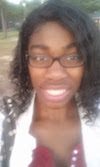
Jasmine Chappell
Mentor: Dr. Francisco Hung
Hello. My name is Jasmine Chappell, and I in the fall, I will be entering my sophomore year at Tuskegee University in Tuskegee, AL, where I major in chemical engineering. My interest in chemical engineering revolves around engineering and optimizing clean, sustainable, and economical forms of energy, particularly oils and biofuels. I ultimately want to obtain a Master's degree in education and teach high school chemistry. I believe the world misses out on so many potential chemists and scientists because of indifferent teachers teaching a daunting subject, and I hope to make a change in that reality in my career. In my spare time, I like to listen to music, and I write fiction.
This summer I ran a molecular dynamics simulation of a deep eutectic solvent (DES) and analyzed its output files. My mentor, Francisco Hung, performs molecular dynamics research on various DESs and other reagents. His research, especially that in regards to DESs is valuable because these solvents have been found to have similar physical and chemical properties to those of ionic liquids (ILs) which are used in dye-synthesized solar cells (DSSCs) to convert sunlight into electricity; however, DESs are nontoxic and much less expensive to manufacture. My research has involved uncovering the fundamental behaviors of DESs on a molecular level, both in nanopores such as they would be in DSSCs, and in bulk.
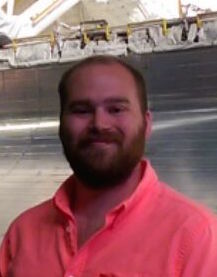
Matt Curtis
Mentor: Rongying Jin
My name is Matt Curtis, I am from Memphis, TN and I am a senior physics major at LSU. I do research in Condense Matter Physics, particularly on topological insulators and topological conductors.
My research this summer was to grow topological insulators in the form of single crystals. Once these crystals were grown I studied their magnetic properties using a SQUID and saw their phase by running them through XRD analysis. Our ultimate goal is to use the properties of single crystals to develop quantum computers.
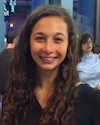
Rebecca DiTusa
Mentor: Rongying Jin
My name is Rebecca DiTusa and I am from Baton Rouge, Louisiana. I will be starting this fall at Louisiana State University as a freshman. I am not sure what I am going to major in, so as of now I am listed under undecided science. I am a former gymnast who enjoys to be active. I like playing soccer, swimming, and working out. I also enjoy playing piano and listening to jazz and pop music.
This summer, my research was to grow a crystal and analyze its properties. The reason I grew these crystals was to see if they had topological insulating properties. In the future, it is thought that topological insulators will be put to use with quantum computing. Quantum computers will run more efficiently while running with topological insulators due to the 2D conducting surface. This 2D surface allows electrons to run through the crystal without bumping into other electrons; since electrons will not hit anything, there will be no energy/heat given off and all energy can go toward powering the computer.

Felecia Foy
Mentor: Dr. Michal Brylinski
My name is Felecia Foy and I am from Shreveport, Louisiana. I am a rising senior at the Louisiana School for Math, Science, and the Arts. My academic interests include computer science and mathematics. In my free time I like to read and watch Netflix.
My research involved working with ZDOCK, a protein docking code. ZDOCK is used in many types of biological research, including drug discovery and development. It works by showing the user how two proteins, or a drug and the ligand it bonds to, will interact together. By doing this it shows how the drug may affect the user and any possible side effects it may have. My goal was to make ZDOCK faster and more efficient by both parallelizing it with openMP and running it on Intel's Xeon Phi MIC. My faculty mentor does other types of research involving computational biology and protein docking.
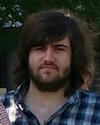
Jordan Frick
Mentor: Dr. Phil Sprunger
My name is Jordan Frick. I am a senior physics major at LSU with a minor in electrical engineering. I am from Slidell, Louisiana. Through my research position at LSU, I am currently investigating the temperature stability of Au on h-BN for CO oxidation.
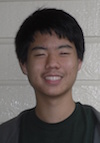
Elvin Gu
Mentor: Dr. Les Butler
My name is Elvin Gu and I am a rising senior at Baton Rouge Magnet High. I have no primary academic interest but I have a strong interest in Computer Science, Physics, and Mathematics. I do take pride in my mathematical and computer science skills and was a participant of the Chemistry and Physics Semifinals. However, I am one of the most laidback people you'll ever meet and spend most of time reading manga, watching anime, and being absorbed in thought when I should be studying. I might seem very unwelcoming or unfriendly but I assure you that conversation is always welcome.

Jessica Hebert
Mentor: Dr. John DiTusa
My name is Jessica Hebert. I am a senior physics major at LSU. My current research involves the characterization of the magnetic properties of certain Fe2P type compounds. In my spare time, I enjoy cooking, going to the gym, and spending an inordinate amount of time watching Netflix.
Interesting magnetic phenomena can occur in magnetic materials that lack a center of inversion in their crystal structure (noncentrosymmetric), such as helimagnetism. Helimagnetism is characterized by a spiral arrangement of magnetic moments. Recently, the Skyrmion lattice state has been discovered in helimagnets when exposed to small external magnetic fields. Magnetic Skyrmions are thought to have potential applications in spintronics. The Skyrmion lattice state is an hexagonal lattice of vortices consisting of magnetic moments. For this project, we are exploring several materials having the Fe2P crystal structure in order to determine their magnetic properties and their potential for hosting a Skyrmion lattice state. The materials under investigation are FeScGe and MnScGe.
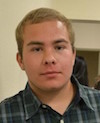
Holden Hyer
Mentor: Dr. John DiTusa
Hello, my name is Holden Hyer and I am from Bernalillo, New Mexico. I am currently a junior at New Mexico Institute of Mining and Technology in Socorro, New Mexico. I am studying Metallurgy and Materials Engineering and believe that this will continue to be my major until I graduate. My hobbies consist of welding, cooking, acting, and fencing. I am a dog person, so I love playing with animals.
Spin electronics, or spintronics, is thought to be an important future technology that will combine the logic and memory functions of processors into one nanoscale device. Spintronics will use magnetic semiconductors such as FeSi and RuGe that work as both a ferromagnetic material and a semiconductor. Spintronics has the potential to reduce heating, increase computing speed, reduce energy cost, and to reduce the size of logic elements.
In spintronics, there is a specific crystal structure type called the B20 structure, which is a non-centrosymmetric, simple cubic crystal structure. Magnetic semiconductors such as FeSi and RuGe form in the B20 crystal structure. Some of these materials order helimagnetically at lower temperatures such as MnSi and FeGe. Applications of small magnetic fields have been discovered to create Skyrmion lattices. Skyrmions are topological structures theoretically predicted by Tony Skyrme. Carriers are asymmetrically scattered by a skrymion lattice creating a distinct Hall effect. The idea in this project was to discover new magnetic semiconducting materials by doping small gap insulator RuGe with Fe and Rh. The hope is that if a ferromagnetic signal is detected, then further tests can be done on the sample to detect and study skyrmions.
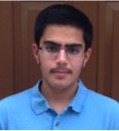
Eshan Joshi
Mentor: Dr. Ram Devireddy
My name is Eshan Joshi. I am a rising senior at Baton Rouge Magnet High School. I have strong academic interests in math, chemistry, physics, and computer science. I love playing badminton, jogging, and reading in my free time. This summer, I plan to get a better idea of what I want to major in college.
My research focused on culturing viable cells and learning about their use in bioscaffolds to facilitate bone regeneration. My mentor's work focuses on a novel approach to bone replacement using an in situ polymerization of adipose tissue derived adult stem cells.
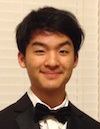
David Luo
Mentor: Dr. Hongyu He
David Luo is currently a rising senior at Baton Rouge Magnet High School. He enjoys researching scientific concepts as well as solving mathematical problems. David has qualified and attended the Intel International Science and Engineering Fair two times (2013 and 2014) and has participated in the Harvard-MIT Mathematics tournament last fall (2014). Apart from academics, David enjoys playing table tennis and practices weekly at the Baton Rouge Table Tennis Club. David hopes to soon publish two research papers and to continue his passion for learning.
The Collatz conjecture remains unsolved today for over sixty years. Although the problem is simple to explain and understand, the nature of the conjecture and the behavior of this dynamical system is difficult to prove or disprove. In this paper, the tree-branch path graphic method for investigating the Collatz conjecture was introduced. Through the tree-branch path, a fundamental graphic structure for this problem was found, and through this structure, the collatz conjecture may be proved to be true for all cases of natural numbers.

Khang Pham
Mentor: Juana MorenoHello everyone, my name is Khang Pham. I am currently a physics major with a concentration in computer science at Louisiana State University. I hope to someday be a theoretical physicist and incorporate computer science in my research and thinking. My involvement in LSU includes the Phi Eta Sigma National Honor Society and the AIAA. During my spare time I enjoy reading, watching anime, playing the ukulele, and listening to music. I hope to contribute much to this summer's research and the future research of physics.
My research for the summer involved the study of Bose Einstein Condensate (BEC), which is a state of matter that only exist in an extremely cold environment. After their collaboration, Bose and Einstein predicted that when Bosons get cool to a very low temperature, they would start to condense and occupy the same quantum state. In other words, these particles share the same lowest energy level. The research yields understandings of how BEC interacts in a disorder system. My mentors' research involves strong interactions of particles particularly how they interact in a disordered system. Therefore the BEC is a good example to study. We want to see the competition between the disorder and the interaction.
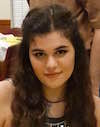
Margarite Picone
Mentor: Kenneth LopataHi, my name is Maggie. I recently graduated from the Louisiana School for Math, Science, and the Arts, where I discovered my love for computer science. I'm attending the Georgia Institute of Technology in the fall. I hope to someday work with artificial intelligence in some way.
Ionization is the process in which an electron is removed from an atom or molecule. Since an electron is negatively charged and a nucleus is positively charged, they experience an attractive force. To ionize the electron, we need a source of energy that is strong enough to overcome the attractive force. In this research lasers are used to create an electric field.The particle now feels an external force from the field, as well as the internal force from the attraction to the nucleus. This is called the potential energy of the atom. The potential forms a barrier that the particle must have enough energy to overcome. However, in quantum mechanics, there is a phenomenon called tunneling. When this occurs, a particle will go through a barrier that it could not overcome classically. The strength of the electric field will alter the potential. The stronger the electric field, the more the potential is distorted, thus the shorter distance the particle would have to tunnel through. As the distance becomes shorter, the chances of tunneling rapidly increases. Adding an electric field to the system also alters the ground-state energy of the particle.
My mentor's research focuses on different ways to model these molecules' orbitals. Since these are complex, functions that are easier to work with are used to approximate the orbitals. Finding the best linear combination of multiple functions will give more accurate results. Once the most accurate model is found, ionization in the molecule can be simulated. This will allow us to study the dynamics of these atoms and molecules, and find the ionization rates. I wanted to find how the strength of the electric field affected the energy level, tunnel length, and therefore the ionization rate on a smaller scale. I used the particle in a one-dimensional box problem (PIB) to study the dynamics of a single electron, and extended this to small molecules.
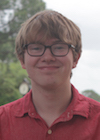
Timothy Shertzer
Mentors: Marc Aubanel and Juana MorenoMy name is Timothy Shertzer and I am from Pineville, Louisiana. I am a rising senior at the Louisiana School for Math, Science, and the Arts. My primary academic interests are computer science and mathematics, but I also have a strong appreciation for the humanities and chemistry. Outside of core academic subjects, I have a major interest in speech & debate and public communications, serving in leadership roles on many levels of the forensics community. In my free time, I also enjoy photography, creative writing, and making new friends.
This summer I contributed to programming, user interface design, and debugging of the WAVE (Waterway Information for Vessels) project, a web and mobile app project being undertaken by Louisiana Sea Grant and a number of individuals in the CCT and elsewhere. The purpose of the app is to provide helpful geographic and geological information, such as maps, charts, weather conditions, and emergency resources, to individuals working in the Gulf Coast region. My contributions to the project were varied. I integrated a substantial amount of new information into the app, such as emergency contact resources and additional map layers, which provide a wide range of potentially useful information. Additionally, I spent a significant amount of time refining the pre-existing state of the app. Debugging and testing was an integral part of my work as I worked with my mentor and other members of the WAVE team to ensure that the app was as polished and efficient as possible. Once the app has been completed, it will be available for free as an iOS, Android, and web app for use by both commercial industries and the general public.
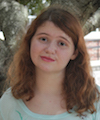
Kate Wheeler
Mentor: Dr. Michal Brylinski
Hi, I'm Kate Wheeler. I attend the Louisiana School for Math, Science, and the Arts in Natchitoches, Louisiana. I'm going to be a senior in high school this fall, and I'm interested in Computer Science and Physics. I'm also involved with my school newspaper, the Renaissance, and the literary magazine, Folio.
This summer, I worked on a project to accelerate the protein docking algorithm ZDOCK. ZDOCK simulates how proteins interact with each other given input files. It is widely used in drug discovery to determine what side effects a drug will have on potential patients. My work to accelerate it was attempting to make the algorithm run on an Nvidia Graphics Processing Unit (GPU). GPUs are very fast due to the development of video games. This is done by translating the original code, which was in the programming language C, to the language CUDA. CUDA is a language especially for programming on the GPU.

Danni Yang
Mentor: Dr. Shane Stadler
Hi, my name is Danni Yang. I am a rising senior at the Louisiana School for Math, Science, and the Arts. I am already planning on majoring in biology/pre-med with a minor in business, even though I have no idea what college I will be attending yet. Since I first learned how to read, I've always been interested in STEM fields. At my boarding school, I am part of the Future Scientists Program and Medical Explorers and have doubled up in science classes since sophomore year. Besides academics, I have been a member of the National Speech and Debate Association since 2013 and received a ranking of Special Distinction. In my spare time, I enjoy reading and writing, but mostly, I love meeting new people and making friends.
Over the course of 6 weeks, I observed experiments performed using an x-ray diffraction machine, RF (radio-frequency) melter, and arc reactor. My project was to determine lattice structures of a specific compound after creating the sample and determining its properties. X-ray diffraction is a technique used to find a diffraction pattern when x-rays are directed onto a crystalline material. The basis of this technique is based on Bragg's law, which states that 2 times the distance between two planes of atoms multiplied by sine of the angle formed between the crystal beam and plane is equal to the integer number of wavelengths multiplied by the wavelength of the x-ray beam (2dsinθ=nλ). Because of this law, as the angle decreases, the distance between the planes of atoms must increase. This change of distance will also change the lattice parameters, which are the lengths of the sides of the crystal structure. If the lattice parameters change too much, the compound loses its optimal magnetization. Once an optimal magnetization is found, this can be used to eventually replace the ineffective and environmentally damaging chemicals used in refrigeration today.
Louisiana Tech University
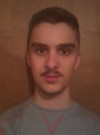
Jeremiah Boswell
Mentor: Dr. Tom Bishop
Hello, my name is Jeremiah Boswell. I was born in Cary, North Carolina, but I have lived in Kalamazoo, Michigan for over 12 years now. In terms of years attended, I will be a junior at Western Michigan University in the fall of 2015, but I currently am considered a senior due to the number of credits I have from dual-enrollment. This credit advantage has allowed me to pursue a double major in both mathematics and computer science. I am somewhat unsure of what I will do with my degree, but I have considered possibility ranging from becoming an actuary to going to graduate school and becoming a professor at a four-year university.
This summer, I worked on one section of an automated workflow for studying the behavior of mononucleosomes on various DNA sequences from a particular species of frog, a mouse, and a sample from a human. My work focused on taking data files generated by analysis programs running with coordinate data as input and creating human-readable statistical plots from them. The reason that the entirety of this workflow has relevance is that by discovering how mononucleosomes behave, how DNA interacts with them, and what effects these factors have on the higher-level chromatin and chromosomes may help to unveil why certain diseases are present in some individuals and not others (certain types of cancer in particular) and how they operate.
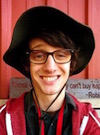
Austen Casey
Mentor: Dr. Pedro Derosa
Greetings! My name is Austen Casey, I was born in Baton Rouge LA but have spent most of my life in western North Carolina. I am currently studying biochemistry at Warren Wilson College in Asheville NC. At my school I am on chemistry crew where I lab and teacher assist for organic chemistry. After receiving my undergraduate degree I plan to pursue a PhD in neuroscience. With this, I plan to become a university professor and conduct research to find better treatments for mental illnesses such as depression and schizophrenia. My academic interests lay primarily in organic chemistry, neuroscience, and physics. In my free time I enjoy practicing guitar, hiking, camping, and fishing. This summer will be my first experience with academic research and I am very stoked to begin. In the fall I have plans to do research in the development of a reusable resin for solid-phase peptide synthesis.
The research I have been a part of this summer was developing a proof of concept code in which nanoparticles may be tracked as they diffuse into or out of a physically entangled polymeric network known as a physical hydrogel. Using MATLAB, a code was developed that allowed for a set concentration of polymer strands and nanoparticles to be generated within a 1 µm3 partitioned box. The release profile of nanoparticles are then plotted on a graph showing an initial burst phase followed by a saturation phase. The rate of diffusion will depend upon the properties of the polymers and nanoparticles used. A major application of this research is in the use of drug delivery, where, a medicinal compound may be administered to specific parts of the body and the swelling behavior and diffusive properties of the loaded hydrogel may be simulated to determine which polymer-nanoparticle combinations are suitable for a particular in vivo experiment.
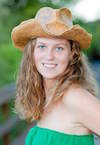
Alaina Fox
Mentor: Dr. Daniela Mainardi
Hey, I'm Alaina Fox, I will be a senior at Berea College, Kentucky, where I am part of the volleyball team. I am majoring in chemistry. I chose this major because it has always been something that interests me and I enjoy doing.I am a Florida native,born and raised,and love to do anything outdoors, I also enjoy reading and going to concerts.
Density Functional Theory is employed to study the adsorption of Carbon monoxide (CO) on Iron Ruthenium (FeRu) nanoclusters. The RPBE functional in combination with DNP basis set under the Generalized Gradient Approximation (GGA) method was employed for nanocluster structural stability analysis and CO adsorption and dissociation studies. The nanocluster with highest Cohesion energy was next tested upon CO adsorption and dissociation using DFT at all different possible catalytic sites (top, bridge, hollow). These simulations are still being run. The CO adsorption energy per atom will be calculated. The hope is to get a negative binding energy, this would mean that the CO is stable when adsorbed to the surface of the catalyst. After determining the most stable adsorption sites, then run the DFT-MD simulations at 25 and 200 degrees Celsius to investigate the conversion of CO and 2H2 molecules to octane over the most favorable FeRu core-shell catalyst.

Steven Hartman
Mentors: Drs. Ramu Ramachandran and Collin Wick
Steven Hartman is a rising senior chemistry major at Cedarville University. He was born in Cedarville, Ohio, has lived there his entire life, and was homeschooled through high school. His love for chemistry began during an 8th grade biology course, when he was introduced to the chemistry behind the photosynthesis/respiration cycle that powers nearly all life. In addition to chemistry, his academic interests include physics, mathematics, and molecular biology. In his (limited) spare time he enjoys video games, Dungeons and Dragons, starting fires, Ultimate Frisbee, volleyball, reading, and wasting time on Tumblr. He is also a member of the Cedarville University Chemistry Club, and served as president of the group for the Spring 2015 semester.
This summer I studied the addition of lithium at or just below the surface of lithium-ion battery anodes, using the Vienna Ab-initio Simulation Package (VASP) to perform first-principles density functional theory calculations. Most of my work was focused on anodes made of ruthenium oxide, tin oxide, and silicon. These calculations were done to determine the voltage of the lithiated electrode, as well as the extent of the volume change that occurs when lithium is added. This work built on the work previously done in Dr. Wick's and Dr. Ramachandran's lab group, which used the same methods to study the addition of lithium to the middle of these electrodes.
The work done in this lab group is part of a global effort to design lithium-ion batteries that perform better than those currently in use. If scientists can find a material that will store more lithium than current electrodes, while having good voltage and relatively small volume change, it will enable the production of batteries which can store more energy. Besides the current market for personal electronic devices, such high-capacity batteries would also be well suited for use in electric cars that would reduce air pollution.
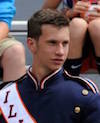
Phil Kagebein
Mentors: Dr. Erica Murray and Dr. Weizhong Dai
My name is Phil Kagebein and I will be a Junior at the University of Illinois at Urbana-Champaign next fall. I am pursuing a degree in Materials Science and Engineering with a minor in Music. Last summer I was fortunate to have an Internship with Hydraforce Inc. They are the worlds largest manufacturer of hydraulic cartridge valves. This summer I couldn't be more excited for my first experience in academic research. I'm also stoked to stay in the south for a summer, I've never really been outside my mid-western bubble.
Aside from staying busy with school work, most of my free time is dedicated towards the Marching Illini. Music has been a huge part of my life since elementary school and I have been a percussionist for about ten years. I am fortunate enough to be a tenor drummer for the Illini drumline; joining this ensemble has easily been the best decision of my life. Perfoming in the Marching illini is such a rewarding experience. I am constantly surrounded by the best and brightest students at my university and have made so many great friends and memories through this ensemble. I hope to earn a spot with the Colts Drum and Bugle Corps. next summer, and spend my summer playing drums for the experience of a lifetime.
This summer I worked with Dr. Murray who fabricates and tests NOx sensors for use in automotives. I initially started off doing computational work with Dr. Weizhong Dai in order to interpret past data Dr. Murray had collected. The ultimate goal was to find a fabrication temperature for NOx sensors that would maximize their sensitivity. After finding this temperature, I made my own samples at this temperature, ran electrical tests on them, and compared those results to prior studies. In general, Dr. Murray works to maximize the sensing ability of these NOx sensors. The EPA keeps making more stringent regulations on the amount of NO in automotive exhaust. Consequently, sensors need to be made that can detect NO in smaller concentrations. The reason the EPA wants cars and trucks to have lower NO emissions is because high concentrations of NO can cause respiratory problems as well as acid rain.
Southern University

Daneisha Blair
Mentor: Dr. G.L. Zhao
Hello, my name is Daneisha Blair. I'm a junior at Southern University at Baton Rouge LA, majoring in Physics with a minor in mathematics. I enjoy studying physics and mathematics because it is the connection to where I can become a meteorologist. The interest I have in our atmospheric environment is what pulled me to these subjects. Obtaining a Master in physics and mathematics is my ultimate objective for my academic career. By laying the proper foundation, I will continue with my perseverance throughout my undergraduate matriculation. My previous two semesters at Southern University, I was fortunate to have conducted research in a physics lab with a physics professor detailing with Ultraviolet Radiation Effects on Some Ceramic Materials. The research project is to understand how some ceramic materials, specifically some rare earth doped LaMnO based materials, are affected by long term exposure to ultraviolet radiation. This summer, I'm looking forward to work on some more interesting science projects. In my spare time, I enjoy playing the piano and socializing.
The overall idea of the project was to find the Microwave absorption of Carbon Nanotubes (CNTs) treated with surfactant (SDBS) material but in order to find it we needed electromagnetic wave (EMW). The reason we needed EMW because it energy gave us the microwave data of reflection, transmission, and absorption ratio. This material is useful for satellites, army planes and expensive equipment use in a research lab. Microwave absorption material can be used to help prevent EMW emission from outside sources to stop interference with the device it is covering. Thus, because of the composites inside the CNTs, it absorbs microwave radiation energy and weakens it. My role in the work was to test SDBS with CNTs to investigate microwave absorption result.
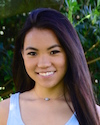
Hyeyon Kim
Mentor: Dr. Laurence Henry
Hi my name is Hyeyon (|hey-yawn|) Kim and I just graduated from the Louisiana School for the Math, Science, and the Arts. I will be attending Vanderbilt University in the fall, where I plan to major in biology and minor in computer science. I have lived in South Korea, South Dakota, Wyoming, and I am currently living in Louisiana. My interests involve social activities, binge watching Netflix, football, reading, and swimming.
This summer, I worked on creating and studying different properties of a ceramic that has a perovskite crystal structure. In the synthesis process, stoichiometric amounts of high purity lanthanum oxide, calcium carbonate, strontium carbonate, and manganese dioxide were grounded together, and the resulting powder was calcined and sintered. The resulting compound in a variety of geometries was structurally characterized using XRD to check the crystal structure. The electrical resistance and magnetoresistance were measured, and microwave absorption was also carried out. Perovskites are ceramic materials that exhibit colossal magnetoresistance- magnetoresistance associated with ferromagnetic to paramagnetic phase transitions that causes a chance in electrical resistance when exposed to a magnetic field. The results of this investigation would broaden the study of magnetism on the physical properties of lanthanum manganite. Studies about the CMR effect could lead to advanced changes in magnetic memory devices, magnetic-field sensors, or transistors.
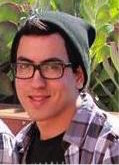
Jerry Martinez
Mentor: Dr. Guoqiang Li
Hi, my name is Jerry Martinez and I am from Los Angeles, California. I am a rising senior at Pomona College, a small liberal arts school right outside of L.A. in Claremont, CA. I am a physics major with a minor in dance and I plan on pursuing a PhD in Mechanical or Aerospace Engineering. In my spare time, I love to play videogames and dance with my hip hop dance crew.
This summer I conducted research for the Mechanical Engineering Department at Southern University. In this project, I investigated the mechanical and shape memory properties of polymer fibers. My research project was a subproject to the work being done on artificial muscle based self healing composites. Self healing composites are types of materials that have the ability to heal crack formations when external heat is applied. This research is important because it is leading to a new generation of materials that can self heal. One big application being studied is the use of these types of materials for airplane wings and hulls. These materials will be able to heal cracks on a plane that otherwise would lead to complete structural failure. Self healing materials have been around for some time, but self healing polymers that can close macro scale cracks have not. Most self healing polymer composites can only close cracks at the micro scale, at hundreds of microns. Our lab has constructed polymer composites that can close macro scale cracks at the millimeter level. This composite makes use of artificial muscles made from common fishing line to act as the actuator that closes the cracks in the material. My particular part in this project was to find a better polymer fiber to make our artificial muscle from. It is our hope to make artificial muscles from this new fiber that can heal even larger cracks.
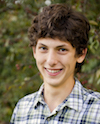
Daniel Polin
Mentor: Dr. Diola Bagayoko
My name is Daniel Polin and I am a rising junior at New York University majoring in physics and mathematics. In my last two years at NYU I have had the opportunity to be involved in research in our high energy particle physics department, specifically working for NYU's branch of the ATLAS Experiment. I am also an adjunct instructor at NYU for their General Physics curriculum, a set of courses which aimed at pre-medical students and other non-physics majors.
This summer I worked with the Southern University Physics Department to perform ab-initio calculations of electronic and structural properties of cubic crystalline sodium oxide (Na2O). Our results were obtained using density functional theory (DFT), specifically a local density approximation (LDA) potential, and the linear combination of Gaussian orbitals (LCGO) formalism. Our implementation of LCGO followed the Bagayoko, Zhao, and Williams method as enhanced by the work of Ekuma and Franklin (BZW-EF). Our group uses these methods to make electronic and structural predictions for various compounds and materials. This research can provide predictive insight into the properties of materials such as electrical conductivity and optical properties without the need for prior experimental testing. This means that in the future this research could be used to discover new uses for materials even before the material is readily available. Na2O for example is a semiconductor used mainly in glass making. However this research could reveal new uses for the compound. Currently our group is focused on verifying that this method gives accurate predictions of materials and it has thus far consistently produced predictions consistent with experimental values for materials.
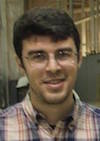
Christopher Schayer
Mentor: Dr. Laurence Henry
Hello, my name is Christopher Schayer and I am a junior at LSU majoring in Computer Science. I just recently participated in the LaACES program with successful results. In my spare time I play clarinet and saxophone as well as cook food. I hope to contribute to this summer's research as well as gain new insight as what research has to offer.
The research examined the effects of magnetic fields and ultraviolet radiation (UVR) on the electron transport properties of La0.4(Sr0.4,Ca0.2)MnO3. Bulk and "thick" powder film samples were synthesized to determine if particulate (powder) samples would yield different results from the bulk. Microwave absorption measurements were also performed to collect data on the material's absorption ratio, reflection and transmission properties. Ceramic-based perovskites that exhibit colossal magneto resistance, such as Lanthanum Manganite (LMO), have seen a growth in interest over the recent years. It already has applications in fuel cell technology, as well as spintronics, and photovoltaics, but due to the material’s metal-insulator transitions, paramagnetism, and ferromagnetism there are many new ways that the material can be utilized. Dr. Henry's research falls into gathering data on the properties of various compositions of perovskites. This is very important because little data has actually been compiled on this type of material.

Robert Stewart
Mentor: Dr. Amitava Jana
My name is Robert Stewart and I'm a junior at the University of Akron in Akron, Ohio. I'm majoring in physics with a minor in mathematics and a certificate in computer physics. I've always enjoyed physics, but it wasn't until recently that I discovered my passion for computer science. I plan to keep working towards a PhD in materials science or computational physics. Some of my hobbies include playing video games, reading, cycling, poker, and learning Japanese.
This summer I continued the development of program to display atomistic configurations in the Cave Automatic Virtual Environment. The interactive simulations being developed here at southern university allow complex systems to be visualized in a real-time 3-D environment. These virtual models could help a scientist better understand the behavior of a physical system or an engineer design and test a complicated machine part. Many simulations involve immense amounts of data which must be processed rapidly in order to remain interactive. To overcome these challenges better and more efficient computing methods are continually being developed. My work involved investigating and testing new methods on existing simulations looking for ways to improve them.
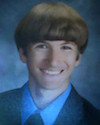
Joshua Ziegler
Mentor: Dr. Diola Bagayoko
My name is Joshua Ziegler, and I am a rising junior at Case Western Reserve University in Cleveland, Ohio. I am majoring in "Physics with a Mathematical Physics Concentration," with minors in Cognitive Science and Astronomy. I am planning on completing a combined Bachelor's and Master's degree before continuing on to get a doctorate in physics. Over the past two years, I have done research on various physics projects with Dr. Philip Taylor. When not in class or researching, I enjoy playing games of any kind, reading, playing the saxophone and spending time with friends and family.
Dr. Diola Bagayoko is leading his group to determine an accurate method by which to determine electronic properties of materials. To that end, our group works on studying materials with the BZW-EF method, and comparing them to experimental results. My personal research this summer was on the ionic crystal Li2O, which has been studied many times theoretically but not often experimentally. The BZW-EF method has been shown to work consistently on crystals composed of larger ions, and arbitrarily complex structure. The work on Li2O continues this work to the limit of small ions, and shows that the method works for arbitrarily small ions. In this way, we would be continuing the group’s work on determining a fully generalizable method to predict the properties of arbitrary compounds. This would ultimately advance materials science research more rapidly than the current method of essentially guess and check development, and would enable greater advancement in many technical areas.
Tulane University

Ryan Bujol
Mentor: Dr. Anne Robinson
My name is Ryan Bujol and I'm from Westwego, Louisiana, a suburb of New Orleans. I am a junior at Spring Hill College in Mobile, Alabama majoring in chemistry. I plan to continue my studies at graduate school, but I haven't quite decided what field to pursue yet. Outside of class, I’m a member of the Delta Chi Fraternity, and I play ultimate Frisbee for my school's club team. I also enjoy playing bass and guitar, going to concerts, and getting in a round of disc golf when I can. This is my first research experience and I'm looking forward to getting started.
Most of my research this summer involved designing, developing, and utilizing a viability assay with SH-SY5Y neuroblastoma cells in order to compare cytotoxicity levels with that of pure tau oligomers. Various levels of H2O2 were added to wells of cells and then ran through a flow cytometer to assess the levels of cell death. One of the focuses of the Robinson lab is in Alzheimer's disease research, which involves testing and experimenting on several factors which are believed to be potential causes for Alzheimer's disease, as well as dementia in general. This includes amyloid beta and tau oligomers, which are known to be potentially neurotoxic. My research was focused on coming up with a range of cell death and stress that is repeatable. By assessing levels to which H2O2 stresses and kills cells, the toxicity of tau can be analyzed in the same manner once a pure sample of oligomerized tau can be attained.

Susannah Cox
Mentor: Dr. Alex Burin
My name is Susannah Cox. I am from Sulphur, a town in southwest Louisiana. In the fall I will be attending the University of Arkansas, Fayetteville. There I will major in Biomedical Engineering with a minor in Computer Science and Arabic. In my free time you can find me trying to learning anything from different languages (spoken and programming) to new discoveries in science, taking photographs, playing tennis, and even cooking. This REU will be my first formal research experience, and I look forward to seeing where this opportunity take me.
This summer I did research on the behavior of low temperature dielectric Two Level Systems in amorphous solids. I used Matlab to write a program that would run simulations of the behavior of the TLS based on a specific equation that calculated the loss tangent of each individual TLS. I then graphed the vales of the loss tangent, tan(/delta),against the frequency shift in units of inverse relaxation time. The results of the simulations showed how when observing few amounts of TLS, around 100 and below, the individual responses are significant when predicting their behavior. It also demonstrates that with large amounts of TLS, roughly around 100,000 and above, the individual responses are not as significant when predicting their behavior. This is due to the fact that they begin to average out at approximately the resonance of the system. This is significant when trying to predict the effects of TLS when working with superconducting qubits and in the development of quantum computers.
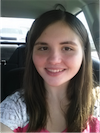
Susan Campbell
Mentors: Dr. Noshir Pesika and Dr. Lawrence Pratt
My name is Susan Campbell, and I am from the tiny town of McCaskill, Arkansas. In the fall, I will be a sophomore Biomedical Engineering major with a concentration in pre-med at Louisiana Tech University. Most of the time, if I am not studying, I can be found at Tech's Association of Baptist Students' Center where I am an officer, as well as a member of their travelling choir. In the rest of my free time, I enjoy reading, hiking, and volunteering, especially when it involves working with the elderly. This REU is the first time that I will have any experience with research, and I am very excited to get started!
This summer, I grew Multi-Walled Carbon Nanotubes using CVD. I first worked to control the packing area density of the MWCNTs. This was accomplished by growing the MWCNTs at different temperatures to determine the optimal growth temperature in order to obtain the highest packing area density. After determining the optimal temperature, I worked to suspend the MWCNTs into microspheres. Both of these projects fit into the broader research being done in the lab I worked in because both are thought to have an effect on the conductivity and electrical capacity of the MWCNTs which is a large focus for those that I worked with. This research is important to the general public because MWCNTs may play a role in future electrical components, especially as technology increasingly becomes smaller.
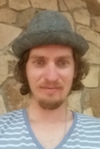
David Huss
Mentor: Dr. Zhiqiang Mao
Hi, my name is David Huss. I am from a small town in the suburbs of Philadelphia called Gilbertsville, PA. I tried college right out of High School in fall 2006 and didn’t like it at the time so I decided to just travel around the country doing volunteer work mostly disaster relief work which is my passion in life helping others anyway possible. I have been a carpenter my whole life and of and on for the past almost the past 8 years I have been a volunteer. I have done mostly done disaster relief work nationally or internationally helping either rebuild or lead volunteers in the field doing cleanup work. I have also in that time gotten to do a year and a half of AmeriCorps. Last spring I ended up in Oregon helping on a friend's farm which I ended up back in college last fall. I am currently finishing up my first complete year of college at Umpqua Community College in Roseburg, OR and will be starting at Southern Oregon University in Ashland, OR in the fall majoring in Chemistry. When not in school or volunteering on a disaster somewhere I love to be outside and go hiking or camping. I also love to go to music festivals and barter fairs. This is my first time ever doing research so I'm really excited to see where this takes me and get started with this REU.
With the recent discovery of novel Iron based 112 type superconductors with Tc of 25k and 45k, it has brought great excitement to researchers wanting to understand the relationship between magnetism and superconductivity and find novel 112 type superconductors with the possibility of a high Tc. From known (La,Ca)FeAs2, (Pr,Ca)FeAs2 and CeNi0.8Bi2 112 type superconductors, we wanted to explore other ReTX2 superconductors. Through this research we synthesized and characterized several 112-type systems ReTX2, (Re=rare earth, T=transition metal, X=Si, Ge, Sb, Bi).
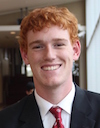
Edward Point
Mentors: Dr. Noshir Pesika and Dr. Lawrence Pratt
My name is Edward Point and I am from the city of Philadelphia in Pennsylvania. I just completed my sophomore year at Tulane University in New Orleans double majoring in Mathematics and Economics. I will be spending the fall touring Europe and in Budapest studying math at the rigorous BSM Program to pursue my interest in graduate studies. I love math and its applications, and have always been interested in applying mathematics to the hard sciences. I am also on the Tulane Rowing Team and a member of the business fraternity, Alpha Kappa Psi. My hobbies are sports, current events, and relaxing every now and then. This is my first research experience and I am very excited for the opportunity.
Our research this summer was to study the growth process of Carbon Nanotubes and their potential as super-capacitors. We specifically grew 15-walled Carbon Nanotubes. We worked on modifying the area density of the Carbon Nanotubes through altering their growth temperature in the Chemical Vapor Deposition Growth Process, replicating results of previous researchers. We tried growing them on different substrates that would be more conductive to electricity and we learned the basics of operating the Electron Beam, used to deposit layers of metal less than a nanometer thick onto the substrate as well as the Electron Microscope to measure our results. We then worked on creating a solution to harden the Carbon Nanotubes into Microspheres which could have application in ultra-light ball-bearings. Finally we worked on the simulations side of research and wrote Python code to solve Discretized Poisson Equations in the 1 dimensional and 2 dimensional cases.
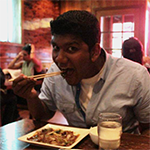
Austin Polanco-Valdez
Mentor: Dr. Noa Marom
My name is Austin Polanco-Valdez I am a Junior double majoring in physics and mathematics with a minor in linguistics at Stony Brook University on Long Island, New York. Ever since I was a young child I have wanted to be a physicist (albeit I didn't always know that's what it was called), so I am very excited to do research this summer. Outside of mathematics and science, I enjoy going on long bike rides all over NYC (my home) and learning new languages.
This summer I developed an algorithm that characterizes lattice mismatch of two different materials. I then implemented this algorithm in a C++ program and wrote a detailed documentation for the program. My mentor's lab does first principles calculations of 2D layered materials and its application are that you can produce materials with a ride range of properties such as some can be superconductors, semiconductors, and insulators.
University of New Orleans

Cristina Azuara
Mentor: Dr. Leonard Spinu
Cristina Azuara was born in San Diego, California. She is the third and youngest daughter of immigrants from Jalisco, Mexico. She attended Hilltop High school and Redwood High in Visalia, California for her Senior Year. Cristina was in AP,honors, compact for success and also was a talented athlete. She competed in track, cross country, volleyball, and surfing. Cristina developed an interest in science while in high school. Education came easy and Cristina enjoyed the challenging science and math courses. As a college student she reinforced her passion for science as she advanced through the completion of math, physics, engineering and science coursework. Cristina has been part of the College of the Sequoias Mathematics, Engineering Science Achievement (MESA) for several years. She has participated in professional conferences such as SACNAS and the MESA Leadership Conference. Cristina has been active volunteer. She has volunteered as a workshop leader for rocketry and architecture in the annual Expanding Your Horizons Conference; a conference to encourage young women to seek careers in STEM. Cristina is a transfer student at California State University of Long Beach. Cristina has worked most of her student life. She was a Barista for a local mom and pop coffee house and Starbucks. She enjoys camping and snowboarding when time permits her to. Cristina will be transferring to CSU Long Beach in the Fall 2015. She is looking forward to be participating in the LA-SiGMA Internship this summer.
This summer I intern for two masters students one is from Nepal and we work with a DC power source connected to a RC circuit, and inside the inductor there is a ferromagnetic thin film. On opposite ends of the inductor are two huge magnets. With the b field that is present what we try to do is to match the resonance of the thin material to the natural resonance of the RC circuit. The other masters student has a dynamic approach we work with using the same ferromagnetic material and but we work with microwaves and we sweep the circuit with a constant b field and look for points of resonance. Each experiment we produce a hysteresis graph and it tells us about the magnetic material and how that magnetic it is and how the magnet retains its information after we apply at b field to it. This is necessary for uses in non-volatile memory in all electronics.

Manish Bhatt
Mentor: Dr. Steve Rick
Hi, My name is Manish, and I come from the laps of the Himalayas in Nepal. I am currently a sophomore at the University of New Orleans, double majoring in Electrical Engineering and Computer Science. I currently do research at UNO in Dr. Zhou's group, working in computational simulations of piezoelectric devices. My areas of interest and intermediate expertise are- Object Oriented Programming, Software Engineering, Signal Processing, Finite Element Analysis, Machine Learning algorithms(neural networks), Genetic Algorithms, and Monte Carlo Method. Additionally, I help manage the TEM/SEM facility here at UNO. During my free time, I enjoy music and playing piano.
My research project during REU is to investigate efficient algorithms for Parallel Tempering/Replica Exchange. More information can be found here. I will be under Dr. Steve Rick's supervision.
The adequate sampling over configurations can be a challenge for molecular simulations. Replica exchange is a commonly used method to help overcome this problem, but it becomes inefficient for large systems. During the summer, we implemented a replica exchange variant which is much better for larger systems (replica exchange with dynamical scaling, or REDS) and explored methods to make it easier for the user and more efficient in general. We implemented our method in GROMACS, which is an open source molecular dynamics software whose source code is freely available, and the system we considered consisted of Alanine Dipeptide with 450 water molecules.

Nirvan Bhattacharyya
Mentor: Dr. Dhruva Chakravorty
Hi, I'm Nirvan Bhattacharyya and this fall I will be sophomore Chemical Engineering student with a minor in Music at the University of Michigan. I am a Michigan native from the town of Saline in southeast Michigan. I'm extremely interested in chemistry and am excited to work at UNO and explore the city of New Orleans. Beyond science and engineering, I love to read, play games, listen to music, and play the cello.
Proteins are the key driver of function in metabolic pathways and other biological systems. These proteins have characteristics that may be altered by the presence of water, ions, and other proteins. Understanding of these characteristics and interactions can lead to improvements in green chemistry and drug design. In the Chakravorty Group, computational methods are applied to various protein-ligand, protein-complex, and protein-aggregate interactions in order to understand the core physical effects driving certain experimentally observed phenomena. My work this summer specifically focused on breaking down the interaction occurring in Zn(II) binding sites in Staphylococcus aureus CzrA and other motifs into component effects such as electrostatics, exchange, induction, dispersion and charge transfer effects. These metal binding sites could potentially contain second shell hydrogen bonds which initiate hydrogen bonding networks altering the conformation, mobility, and function of the protein. Understanding the relationship between metal-ion binding and effect on protein function could aid understanding of many metabolic pathways and improve drug design.
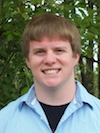
Brandon Buchanan
Mentor: Dr. Leszek Malkinski
Hi guys, my name is Brandon Buchanan. I am from a small rural town in western Pennsylvania called Mercer, about 45 minutes north of Pittsburgh. I am a rising senior physics major and psychology minor at Allegheny College in Meadville, PA. Upon graduation, I plan on going to get my Ph.D. in materials science. I ultimately see myself either in academia or at a national lab working in the field of nanotechnology. Outside of the classroom I also tutor physics, TA physics labs, and am a member of the Society of Physics Students. I additionally am a part of the fraternity Phi Kappa Psi, the physics academic honors society Sigma Pi Sigma, and the psychology academic honors society Psi Chi. For fun I like to play video games, play sports, and hang out with friends.
Thin film Ge/ GaAs solar cells were grown using an AJA ORION-8 Physical Vapor Deposition System. The ORION system is capable of both electron beam and magnetron sputtering deposition. Film crystallinity was characterized via reflective high energy electron diffraction (RHEED). An antireflective coating of MgO was implemented to reduce losses due to surface reflection. The absorption profile of the MgO coating was characterized via a Cary UV-Vis-NIR Spectrophotometer. The reflectance profiles of both the MgO coating and the Ge layer were measured using a Filmetrics F20 Interferometer. Poled ferroelectric nanoparticles of BaTiO3 were utilized as a new method to enhance the electric field produced at the Ge/ GaAs junction. The I-V characteristics of the cells were tested using a Solar Light 16S solar simulator.
The Ge RHEED images showed evidence of epitaxial Ge growth. MgO was found to be optically transparent based on the absorption curve. The MgO AR coating reduced surface reflectance by 39% at a wavelength of 550 nm. MgO also generated a rectifying effect in the I-V curve. Poled BTO nanoparticles reduced dark current and increased light current, while also enhancing the rectifying effect in the I-V curve. Ge did not show any photovoltaic response.
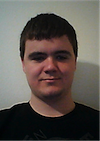
Hunter McDaniel
Mentor: Dr. Leszek Malkinski
Hunter McDaniel is currently a senior at Louisiana State University, with a major in physics and minors in mathematics and history. He will be graduating from LSU in Fall 2015. His future plans include graduate school and a career that pertaining to research. Hunter's hobbies include karate, music, reading, and video games. Currently, Hunter is involved in physics research at his university. His research group focuses on surface science, and he is currently working on a project studying the growth and morphology of Au/Be(0001).
My work is an extension of previous experiments done by Dr. Malkinski's lab where multiferroic samples consisted of 22 µm thick Fe78Si10B12 amorphous ribbons glued to a 500µm thick poled PZT substrate. In my work we used much thinner thin films deposited on specially prepared Si substrates and Au-coated PMN substrates. The magnetomechanical resonance of these samples were then measured using the magnetic field produced by an AC coil and an applied electric field. The substrates of the correct size were placed into a high vacuum system. Then, an approximately 1µm thin film of CoFeB was sputter-deposited on both faces of the substrates using an AJA Orion Sputtering System. The finished samples were then placed into the measurement system consisting of an AC excitation coil connected to a function generator, a DC bias coil connected to a DC power supply, and a sense coil connected to a compensation coil. The magnetomechanical resonance of each sample was then found. The resonance of CoFeB/Si(100) was found to be at 216.83 kHz. The magnetomechanical resonance of CoFeB on all PMN samples has yet to be determined from the data acquired. In the future these materials may be useful in tunable microwave filters.

Leah Strickland
Mentor: Dr. Leonard Spinu
In my research, I fabricated a coplanar waveguide. A magnetic nanostructure was placed on the CPW (coplanar waveguide). The structure was placed in a microwave to test its ferromagnetic resonance.
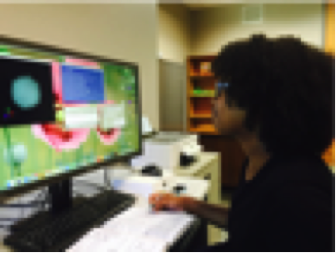
Emyia Woods
Mentor: Dr. Steve Rick
A polymer with an NH3+ charged end was reviewed during this summer research program. The polymer was a modification of a polymer that was created by Scott M. Grayson and Henry S. Ashbaugh. Polymers can be used as drug encapsulators for transdermal drug delivery systems, which is the goal of my mentor, Steven Rick. Transdermal drug delivery systems reduce the side affects obtained by taking pills orally. In addition to this, these systems deliver drugs to the blood stream, which results in more effective drug absorption.
Xavier University

Joshua Adkins
Mentor: Dr. Lamar Meda
Salutations! My name is Joshua Adkins and I am a sophomore at Xavier University. I lived in Burlington, New Jersey for most of my life, but chose to pursue a degree in Chemistry with a minor in Mathematics here in Louisiana. I'd like to extend my minor to philosophy as well, to reflect my love of deep thinking – especially about controversial topics. My current research work involves the synthesis and experimentation of lithium phosphorus oxynitride (LiPON) for use as a solid electrolyte. My future plans include obtaining a PhD in material science and teaching chemistry at a college or university. In my spare time, I enjoy reading, conversing with friends, and playing video games – World of Warcraft is one of my favorites.
Dr. Meda's lab focuses on the synthesis and testing of a variety of transition metal oxides for use as the anode component of rechargeable lithium ion batteries. For the past two months, I have assisted with the experimental development and electrochemical testing of Ni-based materials, particularly nickel (ll) oxide, to this end. With this work, we hope to discover new, more effective materials – with regards to cycling capabilities and capacity size – with which to design these incredibly important batteries, whose use in devices large and small is crucial to human beings.
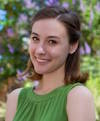
Linden Allison
Mentors: Dr. Galina Goloverda and Dr. Vladimir Kolesnichenko
My name is Linden Allison. I am a rising senior at Juniata College, located in central Pennsylvania. I am a chemistry major with a minor in Russian and I spent the fall of 2014 studying in Volgograd, Russia. I am hoping to pursue a PhD in chemistry after I graduate in the spring of 2016. In my free time I like to hike, read, and play the viola.
Superparamagnetic iron oxide nanoparticles have been utilized in the biomedical field as contrasting agents for MRI. Presently, most contrasting agents are Gadolinium based, which are expensive and have been proven to cause toxic side effects. Utilizing iron oxide nanoparticles can present a less toxic alternative that is just as effective. However, these nanoparticles first need to be encased in an organic coating for biocompatibility. A bridging ligand is required for the nanoparticle to be bound to biomolecules. The bridging ligand explored in this research was based on a class of compounds known as sugar acids, in particular mucic acid. The alpha hydroxyl groups can be protected by binding mucic acid with either nickel or an iron oxide nanoparticle, leaving the beta hydroxyl groups exposed. These exposed hydroxyl groups can then be bound to linkers allowing biomolecules to be attached. Three compounds were synthesized including: nickel phenantrolino mucicate, nickel mucicate, and colloidal iron oxide mucicate. The products were characterized using TGA and ESI-MS.
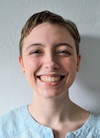
Susannah Davis
Mentor: Dr. Kevin Riley
My name is Susannah Davis and I will be a sophomore at Smith College in Northampton, Massachusetts this fall. I look forward to declaring my major in Engineering Science (General) and possibly a minor in Chemistry. This will be my first research experience and my first time to New Orleans. I live near Chicago and enjoy taking taking the train into the city. My interests outside of STEM include theater (both acting and theatrical design) classics, and garment construction. I am currently working on cleaning up an old electric sewing machine I found at a rummage sale. I am excited to learn more about computational chemistry and materials science, as well as academic research in general. I also look forward to trying some of New Orleans's fabulous food.
My mentor Dr. Riley's work focuses on computational methods for understanding non-covalent bonds, and my lab partner Katie's mentor Dr. Sridhar's lab aims to discover drugs through organic synthesis based on molecular modeling. Our project combined these two focuses. Katie and I spent the summer investigating ligand binding to the two isoforms of nuclear receptor LXR using MOE (Molecular Operating Environment) under the co-grant of our mentors. The two isoforms of LXR (Liver X Receptor) α and β are involved in many functions in the body, including the metabolism of cholesterol and fatty acid, glucose homeostasis, inflammation, and neurological homeostasis. LXR gets its name from the primary location of the α isoform, which resides primarily in the liver. LXRβ is found dominantly throughout the rest of the body. Along with their different locations, LXR α and β can affect the body in different ways, making activating just one or the other very desirable. For example, while both α and β play a role in lowering cholesterol, α will also raise levels of hepatic triglycerides, a contributor to heart disease. If just LXR β could be activated, this side effect could be avoided. We therefore focused on β selective ligands, specifically, using glycine scanning to identify structural features that make ligands β selective. We used these results to generate new ligands with similar features, which will eventually be synthesized. We hope these novel ligands with prove effective agonists of LXR β with minimal side effects, unlike those already in existence. LXR isoform selective ligands show promise for the treatment of hormone-dependent cancer, atherosclerosis, and Alzheimer's disease.
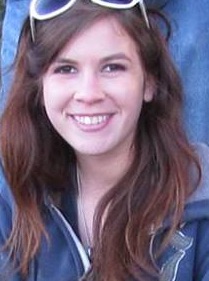
Taylor Gravolet
Mentors: Dr. Galina Goloverda and Dr. Vladimir Kolesnichenko
My name is Taylor Gravolet and I am a New Orleans native. I am a senior majoring in chemistry with an english minor at Spring Hill College in Mobile, Alabama. I intend to continue my education through graduate school to pursue a lifelong career in research.
Iron oxide nanoparticles are being studied for a variety of biomedical applications such as possible carriers for targeted drug delivery and as a contrasting agent for MRI imaging. The use of iron oxide nanoparticles will require several components to ensure effectiveness in the body. One component required is the binding of the iron oxide nanoparticles to a bimolecule by a linker ligand to improve interaction with the biological makeup. 2,5-dihydroxyisophthalic acid was chosen to be synthesized as a possible linker ligand because it possesses multiple coordination sites for nanoparticle attachment. I participated in the synthesis and characterization of 2,5-dihydroxyisophthalic acid and its derivatives.

Katie Hardin
Mentor: Dr. Jaya Sridhar
My name is Katie Hardin and I am from St. Louis, Missouri. I am a rising junior at Boston University studying Biomedical Engineering. I have been involved in research for the past year with a focus on synthesizing polymers to be used as lubrication in joints for the treatment of osteoarthritis. I am very excited to explore the computational aspect of material science, as it will be something completely new to me. Outside of school I enjoy playing with dogs and being in the sun. I can't wait to enjoy the weather in New Orleans.
This summer, my research partner and I worked on a project that our mentors share a co-grant for regarding the nuclear receptor, Liver X Receptor (LXR) and its two isoforms, alpha and beta. Both isoforms lower cholesterol levels when activated, however the alpha form undesirable increases levels of hepatic triglyceride (TG). Our goal was to computationally analyze the binding of several ligands with known selectivity into the alpha and beta LXR proteins in order to determine the structural features of a ligand that made it beta selective. Glycine scanning was performed to determine which amino acids were important for ligand binding, and aided in identifying which structural features were important for beta-selective binding. With these structural features established, a scaffold replacement search generated sixty-two alternate structures to be further evaluated for possible synthetic development. While the main function of LXR are to regulate cholesterol levels, through isoform selective ligands, the potential exists to treat a variety of human diseases, including hormone-dependent cancer, atherosclerosis, and Alzheimer's disease.
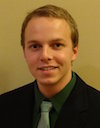
Christopher Miller
Mentor: Dr. Kevin Riley
My name is Christopher Miller, and I am a senior studying Biomedical Engineering at Tulane University. My passion for research revolves around my interest in computation. I enjoy writing code and using programs which solve biological problems. During the semester, I create image analysis algorithms in a biophotonics laboratory. Outside of classes and research, I am involved with the campus biomedical engineering professional society and service dog training program.
This summer I specifically explored the efficiency of computational methods used for molecular modeling of complexes with halogens of the form C-X···π. The broader goal of this project aims to determine exactly how the C-X···π interactions influence protein-ligand pairings where this particular complex form is prevalent. A better understanding of the computational cost of these interactions allows further investigation into how these connections play a role in the biological with more efficient research.
-
-
Summer 2014
-
Grambling State University

Lindsay Davis
Mentors: Dr. Naidu Seetala and Dr. Upali Siriwardane
Hello. My name is Lindsay Davis. In the fall, I will be a graduating Senior chemistry major. I attend Langston University in Langston, Oklahoma, home of the Lions. I enjoy conducting research, shopping, and doing community service with Sigma Gamma Rho Sorority, Inc. In my free time, I love to play my clarinet. My future career aspirations are to become a cosmetic chemist and eventually teach. One word that describes me best is ambitious.
The research project is to increase the efficiency of the Fischer-Tropsch process by targeting the most effective catalyst for the reaction. Previously, different compositions of nanoparticle metal oxides (Co, Fe, and Cu) co-entrapped sol-gels were synthesized, reduced, and ran catalytic reaction. The main objective of my REU project was to study the order of ferromagnetism for each of the samples.
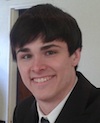
Dustin Sauriol
Mentor: Dr. Pedro Derosa
Dustin Sauriol is currently a senior student at West Virginia Univeristy Institute of Technology where he is double majoring in Mathematics and Computer Engineering. He is active in both the local and international branches of IEEE and has participated in the Student Activities Conference for the past two years. His passion for mathematics and computers was sparked in early childhood, and eventually that passion carried over into a career path. Dustin plans to pursue his Ph.D in Mathematics and aspires to teach math classes at the collegiate level. In his spare time, Dustin enjoys listening to music, playing video games, and spending time with friends and family.
Our research involved studying the electron transport properties of thiophene functionalized metalla-bis(dicarbollide). Some of the previous work conducted within Dr. Derosa's lab includes determining the relationship between conductance and electrode tip distance as well as the type of junction for thiophene functionalized Co-bis(dicarbollide). The focus of the work I conducted during the course of the program was to determine a function of conductance of thiophene functionalized Fe(III)-bis(dicarbollide) with respect to the spin state of the molecule. Prior research conducted outside of this lab has shown both theoretically and experimentally that the spin state of a molecule can be manipulated by an external stimulus such as an electric field. This knowledge combined with the data gathered from our research, we have come to the conclusion that we could potentially manipulate the conductivity of our molecule by applying an external electric field. From the calculations performed, we were able to determine that conductivity is directly proportional to the spin state for thiophene functionalized Fe(III)-bis(dicarbollide); however, future work is still required to determine whether or not this trend is consistent with other molecular configurations. Future work involves studying different transition metals such as Fe(II) and Co for the central atom as well as employing different linking atoms between the thiophene rings such as Au, Se, and P.
Louisiana State University
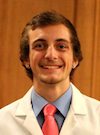
Josef Baylis
Mentors: Dr. Mark Jarrell and Dr. Juana MorenoWhat's good? My name is Josef and I am a junior at Dominican University of California. My major is in Chemistry and my minor in Mathematics. I also have extensive experience in leadership, being a LeaderShape graduate and also hold the position of Director of Communications on my student government. I am looking to advance to medical school after completing my degree and possibly going for a M.D. Ph.D. I enjoy working out, distance running, long walks on the beach, smooth jazz, and earl grey tea. Some of my hobbies include fun facts, having adventures, and evaluating cinematography. This will be my first REU experience. I am looking forward to bringing some of the West Coast with me to the South!
This summer I did research consisting of running molecular modeling simulations via scripts on SuperMike-II. This involved writing and re-writing sections of code within the script in response to the performance and outputs given through multiple iterations. This serves as a sort of beta tester for the greater code being produced by the SiLK group. SiLK stands for “Sign Learning Kink Algorithm”, an alternative method to current methods form computation simulations. An alternative method, such as that supplied by the SiLK method is desirable due to the reduction in the error produced with these evolving methods. A large source of error for these types of simulations comes from the transfer of electron systems from the ground energy state to that of one or more excited states. The transitional zones, referred to as kinks, are the major contributing factor to this error, being that these areas are where sign changes of the charged particles occur. This error causes simulating complex systems near impossible due to the drastic increase of error resulting from this. The SiLK method looks to bypass this source of error while remaining accurate to the expected results.
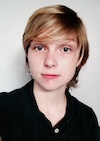
Rhiannan Berry
Mentors: Marc Aubanel and Juana MorenoHey everyone, my name is Rhiannan, and I'm from the little town of Albany, Louisiana. I'm a rising senior at the Louisiana School for Math, Science, and the Arts. My main academic interests are computer science and engineering. My hobbies aside from computers and math are drawing, jogging, and watching movies.
In the words of my mentor, what we were doing was not, in any strict sense of the word, research. It was more of an exploration of various aspects of game design, both old and new. What I did with this information was use it to simulate humans’ involvement in space travel and how it is evolving. It was somewhat of a prelude to future research in the area of 3D virtual reality. I had to learn the basics of two dimensional visualization before taking on a 3D engine in a program like Unity. Much like how I showed the evolution in space flight in my first game, I plan to use my growing skills to introduce knowledge and information to others in a visually pleasing and enjoyable way. This summer project was an introduction not only to game design, but also to further experiences in programming, data visualization, and some of the business side of the video game industry.
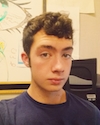
Zack Daniels
Mentor: Dr. Les Butler
My name is Zack Daniels and I am headed towards my senior year of high school at the School of Dreams Academy in Los Lunas, New Mexico. I am interested in engineering, and I have experience in robotics and computer science. In my free time I like to play bass, listen to music, work out, and spend time with friends. I have not yet decided on what I want to major in, although I'm sure it will be some field of engineering. In the future I wish to travel, learn at least one other foreign language, and grow a beard.

Katie Gamble
Mentors: Dr. Dorel Moldovan and Dr. Dimitris Nikitopoulos
My name is Katie Gamble. I am a rising junior at Stevens Institute of Technology and am majoring in Mechanical Engineering. I hope to use my degree to pursue a job working in a naval shipyard. In addition to participating in research on Carbon Nanotube Forests using a Scanning Electron Microscope, I also played soccer for Stevens and enjoy working out to stay in soccer shape.
During the LA-SiGMA program this summer, I worked with Molecular Dynamics simulations to depict mononucleotides immersed in a liquid and traveling through a nanoslit. These simulations, which are run using VMD and GROMACS MD programs, are designed to simulate a new possible method for deciphering a genome. Due to the exponential growth currently occurring in the field of genetics, these simulations represent a revolutionary step in the accessibility of genetic testing to the general populous. While simulations that are presently in use viably decode genomes, they are neither cost nor time efficient. Therefore, we are researching a method by which a simulated DNA strand can be cut, using an enzyme, into single nucleotides and sent through a nanoslit. Through several trials, it was found that, due to various chemical properties of the nucleotide bases, the rates of mononucleotide adsorption differ and cause the flight times to vary over a specified distance along the channel; thus, making the nucleotide bases decipherable based upon their average flight times. However, the simulation in which this was proven contained simplified walls which were not replicable in a lab scenario. Due to this problem, the simulated nanoslit wall parameters must be manipulated further to produce walls that display desired adsorption properties and can be replicated in a lab. This will be done using knowledge of both the wall's chemical and physical (described in hydrodynamic equations) interactions with the nucleotides.
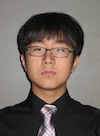
Louie Kam
Mentors: Sonja Wiley-PattonLouie Kam is currently a rising junior at Baton Rouge Magnet High School. He enjoys doing math problems because of the creative solutions and the competition, qualifying for the 2014 United States Junior Math Olympiad and participating at the Harvard-MIT Math Tournament this year. Other than math, he has interests in science, attending the 2014 National Science Bowl, advancing to the double-elimination round. He also enjoys running and playing Frisbee (or trying to). Louie hopes to grow some more inches in the future.
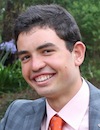
Daniel Lauriola
Mentor: Dr. John DiTusa
My name is Daniel and I will be a senior at Rose-Hulman Institute of Technology, IN this fall. I am planning on double majoring in Engineering Physics and in Optical Engineering. I was born in a small town in Italy and lived both there as well as in the U.S. This first year of College I have been fascinated by the courses that I have taken and am now planning to pursue a Ph.D. after graduating, in order to go into research. I am involved in various clubs on campus and am an officer of the Delta Sigma Phi fraternity. Next year I will be an advisor for incoming freshmen. Apart from school I love playing all sports, doing outdoor activities, and listening to live music.
This summer I worked on probing the magnetic susceptibility of samples Co and Al doped FeSi. Previously work had been done on single Al or Co doping, but my mentor had me add both Al and Co at the same time. The objective of this is to understand if we can fine-tune carrier concentration and magnetization of a semiconductor by sole means of sample doping. The possibility to do so would make it much more cost effective to produce semiconductors with the wanted properties. My part consisted in understanding how varying percentages of Al and Co doping influence the magnetization of the samples. In theory Al should have reduced the magnetization of the semiconductor, while Co should have increased it, but from my summer research it appears that Al might be enhancing it instead. These findings are very interesting and will be further verified by additional measurements in order to understand what is actually happening. From there we can move on to do different measurements in order to see how the carrier concentration varies and how much Al and Co are each changing the characteristics of the semiconductor.
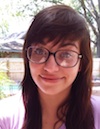
Lauren Lorio
Mentor: Dr. Francisco Hung
My name is Lauren Lorio I am twenty two years old and a Chemical Enginnering major. I live in Baton Rouge, LA and attend Baton Rouge Community College; I will be transferring to LSU next spring to continue my Chemical Engineering degree. I am very excited for the REU program this summer- it will be my first time participating in a mentorship. I've always enjoyed research, but have never had the pleasure to participate in a research opportunity. I have a knack for chemistry, as well as solving practical problems. Also I enjoy reading, playing videogames, gardening, and cooking in my free time.
This summer I researched molecular dynamic simulations of ionic liquids both confined in CMK-3 and in bulk. Ionic liquids are organic salts, which are liquid near room temperature. They are considered green solvents due to their: low vapor pressure, low melting point, high conductivity, high electrochemical stability, high thermal stability, non-volatile, and low flammability. Bulk simulations are necessary in order to fully understand the properties of the confined ionic liquid. The knowledge gained can improve our electrochemical devices by serving as an alternative electrolyte. Research indicated that controlling the nanostructure of the pores could lead to higher storage capacity; this is crucial because it has the potential to optimize technology. Ionic liquids confined inside the nanopores of CMK-3 is the first of three steps my mentor is taking in order to get a full understanding of how pore morphology affects the dynamic, structural, and physical properties of ionic liquids.

Natasha Navejar
Mentor: Dr. Les Butler
My name is Natasha Navejar and I an a recent graduate of Saint Louis Catholic High School in Lake Charles. I am incredibly ambitious and driven to succeed. The past year has been a whirlwind as I've been named Student of the Year, valedictorian of my class, bowling state champion, and have received scholarships to attend Tulane University in the fall to major in neuroscience. I'm a total math and science nerd, but also love just having fun and being social. My hobbies include bowling, exercising, eating, drawing, and hanging out with friends.
My research concentrated on engineering and programming an automated tracking system for moving samples, particularly flame retardants. The system involved a microscope camera with a 3mm2 point of view that had to track a burning sample despite the possibility of sample contortion during burning. My mentor Dr. Butler specializes in high-resolution imaging and tomography using interferometers. He plans to implement an X-ray interferometer in the system’s design in the future to gather both chemical and physical data from samples. The hope is that this machine will be an effective and efficient method for analyzing and gathering data despite sample movement and the microscope’s miniscule field of view. Unlike the typical UL-94 Standard for flame retardant sample testing which gives no indication of the chemical composition that determines a sample’s flammability, our innovative machine will allow manufacturers to create improved flame retardants based on the chemical data acquired.
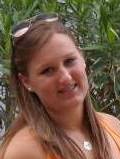
Emily Spustek
Mentor: Rongying Jin
My name is Emily Spustek, and I am from New Roads, Louisiana. I am currently a senior at the Louisiana School for the, Math, Science, and Arts, and I have a great interest in science, especially Chemistry and Astronomy. I plan on majoring in aerospace engineering or chemical engineering. I have played volleyball for the past 7 years and find it to be a great passion of mine. I also enjoy hanging out with my friends and reading novels.
Dr Rongying Jin, my mentor, focuses on the development of novel complex materials with intriguing physical properties, such as new phases that exist on the edge of instabilities. Thus, her research effort is devoted to (1) "science-driven" synthesis and (2) investigation of basic physical properties. Dr. Jin focused me on studying the magnetism of Ca3LiRuO6. To help me better understand this, I first had to research everything I could learn on magnetism. Beyond that, Dr. Jin also had me studying the magnetic properties of a nickel ($0.05). With both the nickel and Ca3LiRuO6, I was responsible for understanding and operating the Superconducting Quantum Interference Device (SQUID). I learned to clean the machine, switch out samples, insert liquid Helium into SQUID, and program SQUID to properly record data while running its course.
Louisiana Tech University
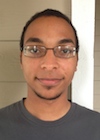
Christopher Bell
Mentor: Dr. Box Leangsuksun
Hello, my name is Christopher Bell. I'm a senior Computer Science major at Xavier University of Louisiana. I've led a few side project with fellow colleagues to create software to help daily activities of students and created the website for Xavier's student newspaper. Also, I enjoy the occasional game of Civilization V. My future goals are to continue to learn more about the software development process and to research more on High Performance Computing.
My research project consisted of mostly of following the Software Development process to create a workflow manage- ment system for a company called Chemure to keep track of the flow of containers coming in and out of their shops. My role in this project was doing the testing part of the Software Development process to ensure the least amount of bugs possible in our project.

Justine Ker
Mentor: Dr. Daniela Mainardi
Hello! My name is Justine Ker, I'm from Ruston, Louisiana, and I will be a Junior at Vanderbilt University next fall as a Neuroscience Major and Psychology Minor. I'd ultimately like to work in the field of neuroscience-related medical research or involve myself in clinical neuropsychology. I'm excited that the LA-SiGMA REU program is giving me the opportunity to explore science under Dr. Mainardi, and I am looking forward to learning how to operate research equipment and how to to analyze and report research data. Aside from science, I am extremely passionate about my music (I play piano and violin), and I love to travel. I spend most of my spare time reading and watching as many YouTube videos as I can.
This summer I researched the optimum porosity for automotive exhaust sensors. My professor, whose focus is on improving gas sensors in order to reduce vehicle emissions and improve fuel economy, finds this relevant as porosity is what determines a gas sensor's sensitivity. My professor's research is important to this field because it is a key process into reducing the overall greenhouse gas emissions of the United States.

Frank Marshall
Mentors: Dr. Erica Murray and Dr. Weizhong Dai
I am Frank Marshall and I just finished my junior year at the Missouri University of Science and Technology in Rolla, Missouri where I am dual majoring in Physics and Applied Mathematics. I hope to attend graduate school and get my doctorate degree in Physics. When I am not in class or doing homework I am typically either doing undergraduate research or working with some technical student groups on my campus that build robots. Other then that I am fairly active. I love playing and watching sports, especially basketball.
Due to the limitation of easily accessible fossil fuels, there has been a rise in the search for alternative energy sources. This increasing need for clean energy sources has led to the study of Fischer-Tropsch (FT) synthesis for the production of liquid hydrocarbons from synthesis gas (H_2 and CO). This synthesis gas can be used to produce highly aliphatic hydrocarbons in the presence of transition metal catalysts. Transitional metals like Co, Ru, Ni, and Fe have been studied as effective catalysts for FT synthesis, and recent studies indicate that Pd could also be a good promoter when added to Co in such reactions. Dr. Mainardi's lab has studied these catalysts in different bimetallic combinations, including Co and Ni, and Co and Fe. My research for this summer involved the study of Co and Pd as a bimetallic catalyst. The preferred adsorption sites and binding energies of a CO molecule on CoPd core-shell and PdCo core-shell nanostructured catalysts of 13, 19, and 38 atoms were determined theoretically through simulations created via Materials Studio. Afterwards, the energy barriers of the different steps involved in FT reactions on the modeled catalysts were determined. The dynamics of the FT reactions at 25 °C and 200 °C were examined as well. While FT synthesis has the capability to produce varying liquid hydrocarbons, my research specifically studied the production of octane.
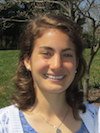
Kate Moyer
Mentors: Drs. Ramu Ramachandran and Collin Wick
Hi, my name is Kate and I am a rising junior studying Chemical Engineering at Stevens Institute of Technology in Hoboken, NJ. Academically, I aspire to work towards at least a master's degree in Materials Science and Engineering. I intend to utilize my degrees to go beyond the scope of textbooks and to make concrete contributions to the public welfare.
In addition to my hours of schoolwork, I love running cross country and track at Stevens and am the professional development co-chair for the Stevens Society of Women Engineers. I absolutely love to cook and bake and love the outdoors. This is my first REU experience and I am really looking forward to this summer!
There is a relentless thirst for enhanced sources of energy in today's society. The battery is a major component for providing power in electronics, specifically in electric vehicles and portable electronics. As the technology industry rapidly expands there is an insatiable demand for longer-lasting and faster-charging batteries. Currently, the energy density of batteries is not enough to meet current demands. This past summer I addressed this situation through computational chemistry and materials science research. Li alloy forming elements such as Sn, Sb, In & Al have attracted significant interest as prospective anode materials due to fact that they have a larger theoretical capacity than graphite, the most popular commercial anode material at present. While tin oxide (SnO2) has been studied extensively, tin sulfide (SnS2) has been examined to a much lesser extent. Details of the mechanisms by which SnS2 functions is unclear, although a combination of conversion, and alloying mechanisms have been proposed. We used first principles computational studies to calculate discharge curves for the sorption of lithium in nanoparticle and crystalline systems of (SnS2).

Inderbir Sondh
Mentor: Dr. Tom Bishop
Hi, my name's Inderbir Sondh [Indy] and I'll be a junior at the University of Pittsburgh next fall. I'm currently studying Bioengineering with minors in Computer Science and Mechanical Engineering. I genuinely enjoy learning and plan to take my studies to the graduate level. I'd like to eventually do research and development work in the medical device industry. I feel that this type of job would satisfy my natural interests and also help a great number of people. I can see already that such a career will involve heavy research/analysis and thus I am very excited to participate in my first REU. Apart from school, I enjoy playing ultimate frisbee, listening to music, and reading novels. I also love watching movies, particularly documentaries.
This summer I worked on the development and optimization of the Interactive Chromatin Web Server [ICM] in an object oriented programming language (C++). The software allows a user to input a DNA sequence, a temperature, and desired energy models. A three dimensional model of the DNA sequence is then generated in both free DNA and chromatin forms. Construction of the model relies on the description of DNA using standard helical parameters. When a sequence is entered, the program first generates a file containing appropriate parameters for all DNA base pairs. These parameters describe translation and rotation of each base pair of DNA relative to the previous pair. Most molecular modeling software requires an absolute description of molecules in space, using a standard right handed coordinate system (in the form of a .xyz file). Our software uses the El Hassan algorithm to take in each base pair’s parameters and assign a set of x, y, and z coordinates to it, along with directors to describe its orientation. This allows us to convert the parameter file into a .xyz file, which is finally fed into the graphic modeling software to produce a 3-D, interactive rendering. The larger scope of the work seeks to integrate this web server with an existing genome browser. The intention is to allow a user to input a sequence, as well as information about the sequence that would cut down calculation time, directly from the browser to the web server. Another goal is to achieve efficient processing of sequences up to 1,000,000 base pairs long.
Southern University

Jermain Franklin
Mentor: Dr. Laurence Henry
I'm Jermain and this is my second summer participating in the REU program. I am an electrical engineering student at LSU. I enjoy playing cards, chess, bowling, and mathematics.
This summer's research was focused on the electron transports through ceramic materials. It also focused on the effects of UV radiation to these materials. My contribution was to synthesize to samples of La.5(Ca.5-xSrx)MnO3 where x=.3 and .4. These samples were tested for electrical resistivity, effects of UV radiation, and magnetism. Also, a sample (x=.3) was fabricated to compare its atomic spacing with a previously fabricated sample of the same makeup. The applications of this research concerns the ability to store and transmit energy through a more efficient material.
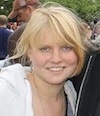
Kira Kelley
Mentor: Dr. Guoqiang Li
Hey, I'm Kira. I'm a junior at the University of Vermont, where I'm from. After taking a gap year (in Baton Rouge) and spending a year at an art school in NYC, I realized I needed more math and nature in my life and transferred to UVM to study Environmental Engineering. I love studying systems and finding ways that different areas of knowledge connect to each other. If I'm not in the library you can find me playing rugby or climbing trees or making music.
The research I did this summer investigated the properties of Shape Memory Polymers (SMPs) and their self-healing capabilities with regards to their potential use in asphalt sealant. We examined two separate types of polymers in both solid and powdered form, performing compression tests with the MTS machine and tracking the expansion recovery of the particles using both LVDT data and liquid displacement. The strength and limitations of the different polymer bases were explored and different variables such as temperature, strain of compression, state of the powder, whether the SMPs were tested in isolation or as part of a cured asphalt matrix, and whether or not multiple compressions reduced the potency of the particles’ self healing capabilities. Other research in the field of Self Healing Polymers investigates the capability of the polymers in an epoxy matrix to be able to heal cracks not only in asphalt but in the siding of rocketships for example or other high-pressure, high-stress structural walls.
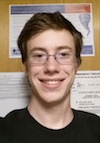
Walter Lynn
Mentor: Dr. Diola Bagayoko
Hello, name is Walter Lynn and I am from Washington, D.C. I am a rising Junior at Carleton College in Northfield, MN. I am a physics major and my current goal is to take every class the department has to offer. My plan after graduation is to enroll in a graduate physics program. This is my first REU although not my first time conducting research. I spend my free time listening to music and playing games or reading books.
This summer the lab I worked in focused on computational approaches to studying various materials, especially semiconductors. Personally I focused on disodium sulfide or Na2S. I calculated electronic, transport, and structural properties of Na2S such as electronic structure and electron/hole effective masses. This work is important because there is a dearth of information on the material. Currently there are a number of ab-initio methods for calculating these properties but only the Bagayoko, Zhao and Williams Method as enhanced by Ekuma and Franklin (BZW-EF) has consistently and accurately determined the correct values for essential properties such as the band gap of the material. Over the summer, I did the work to add Na2S to the list of materials that have been studied with BZW-EF.
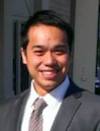
Johnny Om
Mentor: Dr. G.L. Zhao
Hello, I am Johnny Om. I am a junior attending The University of Texas at Tyler. I am currently studying biology at the university. I enjoy carpentry work and backpacking. I believe our success comes from the past. The articles and applications provided to us by our predecessors gives a unique foundation to build for a more practical and efficient society. Continuing education is important to me. I love problem solving. I am fortunate to have wonderful people to guide me and teach me to love everything about technology. I want to be able to be that mentor, even if indirectly, to guide children and future scientists to build upon applications and articles that we may provide in this generation.
The synthesis of the thermoelectric material is highly important for energy conversion. the introduction of fullerene molecules in our work was significant in the figure of merit, or the efficiency of waste heat conversion into electrical power. The fullerene molecules did show improvements into the figure of merit efficiency. However, further studies must be conducted to increase the figure of merit.
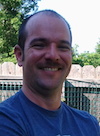
William Raziano
Mentor: Dr. Laurence Henry
I am William Raziano, a sophomore currently attending Baton Rouge Community College pursuing a degree in Computer Science. I plan to attend LSU upon reaching my Associate's Degree to further my education and attain a Bachelor's Degree. While graduate school is certainly not out of the question, my interest in research has brought me to this program. The focus of my education is software, mostly because of the logistic yet creative nature of this growing field. This will be my first REU, and I am quite excited to have the opportunity to take part in this program. I have a keen curiosity, and the processes, disciplines, and techniques surrounding the experimental nature of research intrigue me in a profound way. My hobbies include cooking, gardening, hunting, and gaming. Although the main reason I am seeking a solid education is to be able to have the time for things outside of the scope of work, I am a very determined and hard worker.
This summer, I researched the effects of irradiation of Lanthanum Manganites doped with Calcium and Strontium with ultraviolet light. The purpose of this research was to determine if there were changes to the electrical properties of the sample material. In order to follow the scientific process in the experiment, several steps were taken to ensure that some independent variables were eliminated. This included calibration of UV equipment, calculation of measurements, and making some equipment as needed. The applications of the LaMnO materials include photovoltaics, fuel cells, and spintronics. The fact that minor changes in the doping of the material caused considerable changes to the atomic structure of the materials points to a multitude of unrealized potential applications not including the three previously mentioned.
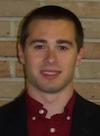
Hunter Starring
Mentor: Dr. Patrick Mensah
My name is Hunter Starring and I am a senior majoring in Biological Engineering with a minor in Chemistry at LSU. I graduated from Fontainebleau High in Mandeville, LA in 2010 and have been at LSU ever since. My plans after graduation are to either attend medical school or attend graduate school for Biological Engineering. This is my third research internship and specifically my second REU. My first research internship was at NASA's Stennis Space Center and my first REU was in the Department of Chemistry at the University of Memphis. In my free time I enjoy playing every sport under the sun such as golf, soccer, football, tennis, and volleyball.
Diesel Particulate Filters (DPFs) are becoming a more effective solution to meet the stricter regulations being placed on diesel vehicles from the Environmental Protection Agency (EPA). However, DPFs are costly and a method of catalyzing the regeneration of these filters using metals is the focus of much research. We developed a novel method of Electroless Nickel Deposition onto the surface of Silicon Carbide (SiC) Ceramic Foam DPFs to harness the catalyzing characteristics of Nickel in the exhaust of diesel engines to develop a continuously regenerating filter. The characterization of Nickel (Ni) on the SiC DPFs surface was confirmed using SEM/EDX. These filters were then tested in the exhaust of a 1-cylinder diesel engine using pure diesel fuel while chemical and differential pressure data was collected. In turn, we can confirm that SiC DPFs are sufficient in reducing particulate matter in diesel exhaust. However, only one of the two products of catalytic regeneration (NO2 and CO2) increased for the Ni Plated SiC filters.
Tulane University
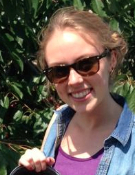
Victoria Calteaux
Mentor: Dr. Scott Grayson
Hello everyone! My name is Victoria Calteaux, and I am a rising junior at Loyola University Chicago. I am studying Biochemistry with the goal of pursuing a PhD and working in research. I am very interested in the medicinal/pharmaceutical applications of organic chemistry. I'm excited to explore New Orleans' cuisine and music scene, as I have only visited in the past. I love seeing live music and spending time outdoors. In my free time I enjoy learning about astronomy and watching shows about space. I also love cooking and learning about how food is made. Just about everything involving the natural world is fascinating to me, so many of my interests surround the central theme of trying to better understand how it all works.
This summer I performed a dendritic synthesis based on 2,2-bis(methylol)propionic acid (Bis-MPA) for future analysis via positron annihilation spectroscopy. Using a monopentaerythritol core, I grew dendrimers to the second generation. Dendrimers are of great importance because they can be used as drug delivery vehicles. Bioactive groups can be covalently attached to the end groups of these dendrimers, including anticancer doxorubicin and amoxicillin, allowing for more specialized drug delivery. A study using positron annihilation spectroscopy (PAS) will be conducted on the dendrimers I synthesized, allowing us to learn more about the properties of these important molecules.
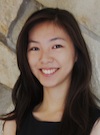
Alyssa Chuang
Mentor: Dr. Zhiqiang Mao
My name is Alyssa Chuang. I grew up in New Orleans and loved it so much that I stayed to attend Tulane University. I am a rising junior majoring in Engineering Physics. My passion for physics was sparked by an amazing junior high math teacher, and I am excited to pursue my interests through research this summer. Besides physics, I am also interested in computer science and coding. In my free time, I enjoy reading, running, and finding the best sushi in town.
This summer, I studied the effects of intercalation of copper into the layered materials TaTe2, TaSe2, and black phosphorus. These host materials contain Van der Waal gaps in between each layer, allowing for intercalation of copper ions through electrochemical deposition. We measured the newly-intercalated material’s resistivity using a physical property measurement system, recording resistivity at temperatures down to 2.2K. Cu intercalation by electrochemical deposition into other materials has been shown to induce superconductivity at extremely low temperatures. My faculty mentor Dr. Mao and his research group focus on low temperature condensed matter physics. They grow single crystals of various materials and perform measurements to observe which materials produce novel quantum phenomena, namely superconductivity. Superconducting materials have advanced academic applications (e.g. particle accelerators) as well as practical uses for future technologies (e.g. Maglev vehicles).
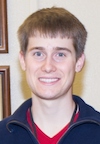
Justin Huckaby
Mentor: Dr. Anne Robinson
Hello, my name is Justin Huckaby. I will be a senior this coming fall at Louisiana Tech University in Ruston, Louisiana. I am majoring in Biomedical Engineering with a minor in Chemistry. Math, chemistry, and biology have been my favorite subjects since high school, so Biomedical Engineering has been a perfect fit. I have received some previous research experience at Louisiana Tech in a cellular neuroscience lab. My experience began during my sophomore year of college. I completed a computational research project and assisted a graduate student in characterizing novel nanomaterials. From this previous research, I have learned much about cell culture practices. I also developed a love for research and academia. I take my course work seriously, but during my free time, I enjoy exercising, listening to music, cooking, and eating. Although I conducted some research at my home university last summer, this will be my first REU. After obtaining my Bachelor’s degree in Biomedical Engineering, I intend to continue my education in graduate school. My passion is to learn and research drug delivery techniques for better and more effective treatments of diseases such as cancer and diabetes.
My summer REU project was in the chemical and biomolecular engineering lab of Dr. Anne Robinson. Dr. Robinson's lab focuses their research on characterization and utilization of various proteins on an atomic and molecular level. Two major categories of proteins being studied are G protein-coupled receptors (GPCRs) and tau protein. GPCRs are membrane proteins and used in cellular signaling in order to regulate ATP energy and other biochemical processes in the cell. These receptors are also targeted by many pharmaceuticals on the market and being studied further in order to develop better drug delivery mechanisms for safer and more effective treatment of diseases such as cancer. Tau protein and its aggregation are currently being studied by many neuroscientists due to its abnormal presence and expression during the neurodegenerative disease of Alzheimer's. A better understanding of tau protein could lead to earlier detection of Alzheimer's and possible treatment options. For my REU at Tulane, I focused on a specific GPCR known as the adenosine A2A receptor (A2AR), which is found in the basal ganglia of the brain. Although only few GPCR structures are currently known, the structure of the A2AR is known, thereby allowing a wider variety of biomolecular studies and experimentation. My goal was to determine the importance and relevance of three extracellular disulfide bonds found within the receptor. I compared a wildtype A2AR containing all three disulfide bonds with a mutant variant lacking the three disulfide bonds. Assessment of receptor expression, trafficking to the plasma membrane, purification, and ligand-binding affinities led to the conclusion of these three disulfide bonds as being critical to the activity of the A2AR. My work on this project not only provided more data and additional questions for the Robinson lab, but I also aided in further characterizing a GPCR's activity. Since the A2AR is found in the brain and studied for neurodegenerative diseases such as Parkinson's, my results could prove beneficial to the development of new pharmaceuticals for the treatment of these diseases.

Lauren Luce
Mentor: Dr. Scott Grayson
Hi! My name is Lauren, and I'm a junior chemistry major and math minor at Nicholls State University (which is about an hour from New Orleans). I'm a proud member of Phi Mu Fraternity as well as a few other organizations on campus (BCM, Colonels Against Trafficking, Math Club...). I've had fun this semester re-starting the chemistry club at my school that hasn't been active in many years as well as the privilege of taking a laboratory internship class where I was able to be a T.A. for a general chemistry lab under a great teacher. I watched Dr. Grayson give a presentation on his research last fall, and I'm super excited to be doing organic synthesis research in his lab! I can't wait to spend spend time on Tulane's campus enjoying New Orleans this summer! I look forward to taking yoga classes at a nearby studio in my free time and getting to know the other researchers!

Hakm Murad
Mentors: Dr. Noshir Pesika and Dr. Lawrence Pratt
I am from the greater New Orleans area and currently a junior studying Biomedical Engineering with a minor in mathematics at Tulane University. My passion for the sciences was ignited at an early age by my father, and I plan to pursue a masters in Biomedical Engineering. I am excited to learn a great deal about carbon nanotubules through the research we will be doing this summer. Research helps foster a unique learning situation in which you are completely dedicated in the pursuit of set academic goals. In my spare time I enjoy playing football, weightlifting, and car circuit racing. I have always had a passion for sports and I plan to compete in an American tour as a racing driver for my home town racing club next fall.
Supercapacitors, as energy storage devices, bridge the gap between conventional capacitors and rechargeable batteries. They combine the high energy storage capability of batteries with the high power delivery capability of capacitors. Supercapacitors can be used to store many alternative forms of energy, dramatically increasing the efficiency of energy forms such as solar. While superapacitors are understood at a theoretical level, we have not been able to synthesis them using readily available components or environmentally conscience solvents. Carbon Nanotubes (CNTs) are desirable for making supercapacitor electrodes because of their good electrical conductivity, high porosity and high electrolyte accessibility. In addition to these properties, carbon nanotubes (CNT) are very light and are capable of high and rapid charge transport when properly stacked. Aligned CNT electrodes are predicted to have better charge storage and transport properties than entangled CNTs as a result of higher pore structure regularity. In the present study, aligned CNT arrays are fabricated at varying heights and used as electrodes in supercapacitors with electrolytes consisting of an ionic liquid in an organic solvent. Galvanic Cycle and Cyclic Voltammogran measurements were used to characterize our CNT supercapacitor electrodes capabilities. We were able to show CNT’s acting as supercapacitors, and with some future adjustments could be market ready.
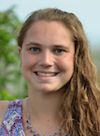
Katie Weiss
Mentor: Dr. Hank Ashbaugh
My name is Katie Weiss and I'm from Upstate New York in the small town of Floyd, which is between Rochester and Albany. I am a freshman Biomaterials Engineering major at Alfred University in Alfred, New York. I hope to pursue a PhD and have a career in medical research. At Alfred, I am president of both Society of Women Engineers (SWE) and pep band. I enjoy playing french horn and trumpet with some occasional tuba. I love playing sports, and even though I am not on any university athletic teams, I enjoy becoming involved in various athletic opportunities. In addition to enjoying a lot of time with my family and friends, I enjoy baking and quilting. I’m very excited to experience New Orleans, as I have never been before and it will be completely different from rural New York.
The hydrophobic effect analyzes the adage "oil and water don’t mix." It drives assembly in aqueous environments including surfactant micellization, globular protein folding, biomembrane formation, and the environmental fate of pollutants. In this study we have examined the solvent's role in methane/methane interactions in liquid water as an idealized system for teasing apart the thermodynamics of hydrophobic association. We have performed computer simulations over a wide range of temperature from the freezing point to the boiling point of water, to examine the entropic and enthalpic signatures associated with hydrophobic interactions. Specifically, we have developed a new approach to extract water’s contribution to methane hydrophobic interactions from distant separations probed directly by computer simulations to the overlap limit that simulations do not directly observe. This new approach takes an interpolative perspective to examine water mediated interactions in the unobserved overlap limit by obtaining the free energy of two methanes in complete overlap (no separation) and using a polynomial to bridge from the overlap limit to the observed behavior at finite separations. We performed computer simulations of a single methane and methane with twice the interaction strength to evaluate the overlap free energy using thermodynamic integration. These calculations are providing new insights into the differences between hydrophobic hydration (solvation of a single methane) and the hydrophobic interaction between two methanes. Our new polynomial interpolation permits a smooth and accurate description of solvent mediated interactions over all separations. The success of this interpolation lies with the ability to accurately evaluate the free energy of bringing two methanes from infinitely far away to direct overlap. This project is part of the larger project in the Ashbaugh lab in which the similar techniques are being used to analyze the free energies of the same system at varying temperatures and pressures to evaluate the variance with temperature and pressure dependence.
University of New Orleans

Brandon Buchanan
Mentor: Dr. Leszek Malkinski
Hello, my name is Brandon Buchanan. I am from a small rural town in western Pennsylvania called Mercer, about 45 minutes north of Pittsburgh. I am a rising junior physics major and psychology minor at Allegheny College in Meadville, PA. Upon graduation, I plan on going to get my Ph.D. in either physics or materials science. I ultimately see myself working in the area of solid-state physics, specifically with either spintronics or nanotechnology. Outside of the classroom I also tutor physics and am vice president of the Society of Physics Students. I additionally am a part of the fraternity Phi Kappa Psi and the psychology academic society Psi Chi. For fun I like to play video games, play sports, and hang out with friends.
Dr. Malkinski's research (as well as mine) centers around a division of materials science called Thin Film Deposition. It involves utilizing physical deposition techniques to deposit extremely thin layers (fractions of a nanometer to several micrometers) of material onto a substrate, the starting material. For my project, I used an aluminum oxide substrate as my starting material. The overarching goal of my project was to find out if zinc can be grown epitaxially (as a single crystal) under certain conditions. If it can in fact be grown epitaxially, we can use it as a new sacrificial layer for rolling films The sacrificing method of choice for zinc is via sublimation, as zinc has a very low boiling point for a metal (around 200°C under high vacuum). Upon sublimation, the films on top of the zinc layer would be released and roll due to different lattice constants (physical dimensions of a unit cell in a crystal lattice) that cause stresses. Zinc is a very difficult element to grow as a film, so we implemented the idea of a seed layer between the aluminum oxide substrate and zinc layer to promote epitaxial growth of the zinc layer. We tried two different seed layers: 10 nm of ruthenium and 50 nm of titanium. My project has a lot of applications since thin films have uses in micro-electro-mechanical and nano-electro-mechanical systems, magnetoresistive random access memories, magnetic sensors, stress sensors, biosensors, metamaterials, and tuneable microwave devices.

Manvitha Marni
Mentor: Dr. Leonard Spinu
My name is Manvitha and I am a rising junior majoring in chemical engineering at Washington University in St. Louis. I started working on my first research project, which dealt with the synthesis of biodiesels, in high school, and I have been fascinated by engineering ever since. I'm excited to work in the Spin Dynamics Laboratory this summer, and look forward to the chance to explore another STEM discipline. In my spare time, I serve as senior news editor for my school's student-run newspaper, Student Life.
This summer, I worked in the Spin Dynamics Lab at the University of New Orleans. My primary project was coating anodic aluminum oxide (AAO) templates with various metals and comparing the magnetic properties and length of the Ni nanowires fabricated with those templates. I also worked on a side project in which I fabricated Ni-Fe alloy nanowires, though I was not able to complete this project over the course of the REU. Nanowires are used in several other projects in the Spin Dynamics Lab, including a project that aims to create nanowires arrays that can be rearranged when exposed to a current. Being able to rearrange an array of nanowires has important implications for data storage as it eliminates the need for multiple different arrays. This in turn allows electronic devices to be made smaller and produced at a lower cost.

Andy Vuong
Mentor: Dr. Steve Rick
Hey y'all. My name's Andy, and I'm a senior at Wake Forest University. I'm working on earning my Bachelor of Science in biophysics with a secondary major in mathematics. I enjoy spending time with my fam and friends, playing the guitar, reading, and listening to hip hop. I've always been intrinsically fascinated with science, and as I learned more about its real world applications, my decision to pursue a career in research became easier to make.
I studied molecular dynamics models in computational chemistry. More specifically, I compared the efficacy of simulating the motion of ions in ethylene carbonate, a common solvent used for batteries, for models GAFF and OPLS. The goal was to optimize the models. I performed energy minimization in terminal to compute the geometry and dimer energy of an ion and a single molecule of ethylene carbonate. I compared these values to quantum theory values. I also computed the free energy for GAFF and compared those values to experimental data. The broader scope for this research is to increase knowledge about solvents used in the production of batteries, for which these models can be used.
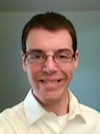
Steve Wagstaff
Mentor: Dr. Steve Rick
Hi, my name is Steve Wagstaff, I'm going into my Junior year at Missouri University of Science and Technology majoring in nuclear engineering with a minor in math. This will be my first experience with research and I'm looking forward to learning everything I can and hopefully making some friends along the way. In my free time I enjoy anything that can get my mind off my day to day problems for a little while like gaming, exercising (I love running), and reading.
Molecular mechanics models in computational chemistry are used to understand the dynamics behind interactions at the molecular level. Ethylene carbonate is one of the most common solvents used for the production of batteries in cars, phones, and laptops. Using the commonly used models GAFF and OPLS, the dynamics of the ions fluorine, chlorine, bromine, iodine, and potassium in ethylene carbonate are studied to better understand the efficacy of the materials used in battery production. Using known calculated quantum theory values for the dimer energy and geometry between an ion and a single molecule of ethylene carbonate, it was found that both the GAFF and OPLS models were accurate in reproducing solvent-ion interactions. In addition, for the GAFF model, free energy calculations were performed to further validate the model with experimental data. For each of these calculations, the optimal values for sigma and epsilon stayed consistent with trends following the size of the ions. These models with their optimized input values can more accurately simulate the interactions between ethylene carbonate and the given ions, thus leading to better results. A great benefit of using models is being able to predict the outcome of a physical experiment prior to actually performing it, which saves both time and materials.

Camera Whicker
Mentor: Dr. Dhruva Chakravorty
Hello! My name is Camera Whicker, and I am a rising junior at the University Of New Orleans. I am currently majoring in Mathematics with a concentration in Actuarial Science. This field fascinates me because actuaries manage risks, and I am a risk taker. Math has always been my strength, so why not exercise it? This summer would be my first time conducting chemistry related research and I am extremely enthused. Last summer I participated in the LSU Smile Program for math undergraduates, so it would be nice to step outside my comfort zone.
Understanding the nature of interactions between surfactant molecules will provide molecular insight into the structure-property relationships that are responsible for surfactant action. In this study, we present an analysis of the conformational dynamics study of surfactant molecules in different solvent models and salinity conditions using molecular dynamics (MD) simulations. Towards this, we performed MD simulations on the well-characterized dodecyldiphosphocholine (DPC) surfactant. Our simulations provide atomistic insights into the conformational ensembles sampled by the surfactant molecules in the commonly used SPC/E, TIP3P, TIP4P and TIP5P water models. We further study the influence of Na+Cl- and K+Cl- ions on the conformational dynamics of surfactants molecules. We are currently expanding our studies to investigate the self-assembly of 54 randomly dispersed monomers in similar conditions. Determining the self-assembly pathways will help us understand inter-monomer interactions and provide a means to develop a theoretical surfactant model for prediction of solubility of large molecules.
Xavier University

Tyranisha Gibson
Mentor: Dr. Jaya Sridhar
My name is Tyranisha Gibson and I'm a biomedical engineering major at Louisiana Tech University. I will be a sophomore in the fall. One of my favorite things to do is reading.
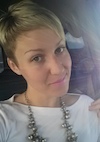
Anastasia Labeaud
Mentors: Dr. Galina Goloverda and Dr. Vladimir Kolesnichenko
Hello, my name is Anastasia LaBeaud. I am originally from Voronezh, Russia. Back at home I was studying soil biology at Voronezh State University, but for the past 2,5 years I have been attending Xavier University of Louisiana, and loving every minute of it! I am majoring in biology with chemistry minor. While english is my second language, it did not stop me from being on the Dean’s list every semester since enrolling in college. I tutor general chemistry in on-campus resource lab and volunteer at chemotherapy department at Oschner. I’m very excited to devote this summer to my very first scientific research. Besides being a nerd, I love doing curcuit training [as well as various fitness challenges] and DYI home-improvment projects [fabric as wallpaper, anyone?], growing organic garden in my back yard [cherry tomatoes and blueberries are ripening as we speak!] and cooking [I proved many wrong that Russian girl CAN cook real creole cuisine ].
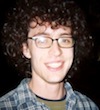
Carl Mitchell
Mentors: Dr. Galina Goloverda and Dr. Vladimir Kolesnichenko
My name is Carl and I'm a senior at Oberlin College/Conservatory in Ohio majoring in biochemistry and jazz performance. Having always been interested in science, I am currently most interested in the biomedical field for its ability to better lives in unique and meaningful ways. For the past year I've been working on a project that seeks to integrate biochemistry and nanotechnology to develop a novel treatment for ovarian cancer. My other lifelong love is music, and I spend most of my free time writing music, playing in bands, and collecting records.
Many medical diagnostics rely on magnetic nanoparticulate matter for imaging applications, and there are also treatments using magnetic nanoparticles as drug delivery and hyperthemic agents. Currently, it is standard to have a polymeric coating to the nanoparticle, such as polyethylene glycol or Dextran. However, these polymers are physically bulky molecules, and interfere with the magnetism of the particle. The goal of this project is to synthesize a small molecule that will adhere to the surface of an iron oxide nanoparticle and protect against aggregation as well as providing a subtrate for coupling to drugs or biomolecules.
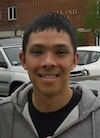
Cole Umemura
Mentor: Dr. Kevin Riley
My name is Cole Umemura and I am currently a Junior at Gordon College studying physics as part of a 3-2 engineering program. Starting in the fall of 2014, I will transfer to an engineering school to complete the program. I will be studying electrical engineering, and may minor in materials science. I am very interested in many scientific fields, but I especially enjoy thinking about environmental sustainability in its many forms. I love to play and watch all kinds of sports, and enjoy video games, movies, and books. I look forward to living in New Orleans for the summer--I've never been there and I am especially excited for the food.
This summer, my lab partner and I explored various characteristics of C- X…π interactions, which is a variation of a type of chemical bond called halogen bonds. This work was all done computationally; there were no actual chemicals or molecules involved. C-X…π interactions are found in certain proteins when they interact with ligands and we set out to explore how the strength of this bond could be adjusted by changing the chemical make-up of the molecules (also known as tuning) and how sensitive the bond strength is to the position of the molecules in relation to each other (a property known as directionality). Dr. Riley is very involved in research involving protein-ligand interactions, and though we did not specifically look at those complete interactions—in fact the methodology is very different from his other research—this research has a part in further understanding those interactions. His ultimate goal is to find a cure for cancer through his protein-ligand research, and we hope that our research this summer lends to a more complete understanding of how to go about doing that. Though our work was small, it has revealed that C-X…π interactions are not quite as directional as we expected them to be, and perhaps that lends further understanding to protein-ligand interactions as a whole.
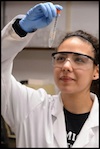
Mariela Vazquez
Mentor: Dr. Kevin Riley
My name is Mariela Vazquez and will be a senior this Fall 2014. Born in Phoenix, AZ raised a Texan in the itty bitty town of Clint, 30 minutes outside of El Paso I moved to Corpus Christi to attend Texas A&M-Corpus Christi through my older brothers' influence. I am currently pursuing a Bachelor of Science in Chemistry with an emphasis in Environmental Chemistry in hope that it will lead to a doctorate in Chemistry. When I am not in lab enjoying synthesizing novel compounds; my interests include reading thriller novels, hanging out with friends and boyfriend, working out, watching comedies, and taking care of my two little dwarf hamsters, Gordita and Turbo.
The project I was assigned this summer was in computational chemistry and was over graphing potential energy graphs of a new halogen bond system. The system under observation was a benzene ring and an alkyl bromide; due to halogen bonding’s recent discovery of their analogy to weak hydrogen bonds. To validate the data collected, comparison of methods was determined in the beginning of the summer of a more vigorous computation method to the one currently in use. In conclusion to our findings we were relieved that our cheaper calculations were in a relative ballpark to the more expensive calculation as well as discovering that C-X∙∙∙π interactions were not as directional as traditional halogen bonds, but were still slightly tunable. Work currently in progress in Dr. Riley's lab is the comparison of the liver receptor X alpha and beta and ligands that may bind stronger to one form. As observed with many proteins a form is favored over the other helping in the later drug delivery system. This work coincides with our project on a much larger scale because of proteins ligand interactions with incorporated halogen bonds.
-
-
Summer 2013
-
Louisiana State University
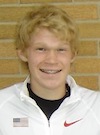
Mitchell Brickson
Mentor: Dr. Dana Browne
Hello, I am Mitchell Brickson. I'm from Yellow Springs, Ohio where we love nature walking and natural spring water. Academically, I'm a math and physics major and I'll be a junior this fall at Goshen College with hopes of going on to graduate school after graduation. My goal is to become a researcher in theoretical or experimental particle physics after that. I'm a dedicated track athlete, for which I'm going to a national competition at the end of May. I tend to be a generally positive person, and I hope to share that wherever I go.
This summer, I did computational research on the properties of transitional metal germanides with a focus on manganese germanide working under Dr. Browne. Computational guidance for Dr. DiTusa's experimental condensed matter groups here is one of Dr. Browne's broader research focuses. The goal was to look for properties of the material that might be interesting to study experimentally. Among other things, we found computational evidence of a magnetic transition under pressure that lead to a dramatic drop in magnetic moment as well as a shift to a half metallic state. This is particularly interesting because one of Dr. DiTusa’s goals is research for the applicability of spintronics, a sort of gateway to new forms of information processing that could potentially provide room for improvement beyond what electronics are currently capable of, and the study of half metallic materials is essential to that.

Eric Dilmore
Mentor: Brad Burkman and Dr. Juana Moreno
My name is Eric Dilmore and this fall I will be a freshman at the University of Texas at Dallas. I plan to major in Computer Science, which I found a passion for in the last three years since I started writing small Applescripts on my Mac. I enjoy spending my time singing, acting, playing trumpet, reading, and breaking things on Linux.
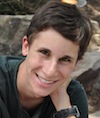
Mark DiTusa
Mentor: Dr. Phil Sprunger
My name is Mark and I am an incoming sophomore in Physics and Chemistry at LSU. I feel that my majors indicate more about my indecision towards what science I love the best, but it can also show my passion towards discovering mysteries in nature. When not up to my head in school work, I enjoy video games, ballroom dancing, and board games.
This summer I worked in Dr. Phillip Sprunger's lab, located in Nicholson Hall. His group studies the surfaces of materials by placing them within an ultra-high vacuum chamber and using spectrometry tools such as electron energy loss spectra (EELS) and low-energy electron diffraction (LEED). The project, headed by one of Dr. Sprunger's graduate students, Chad Thibodeaux, was centered upon better understanding the generation of environmentally persistent free radicals (EPFRs) by studying the surface of ZnO when dosed with phenol, which would create an EPFR that is generated within the environment. We used EELS and LEED before and after the dosing of phenol to see the effects that phenol would have on the surface structure, and from that draw conclusions about the EPFR itself. One question that is yet to be answered is where the extra electron (from the free radical) is ending up on the stable ZnO-phenol molecule. The grander scheme of the project is to study EPFRs as they are known to cause lung disease and even cancer, and other projects with different angles (such as one that is taking place within the Biology department at LSU) are dealing with the biological effects of EPFRs on rats.
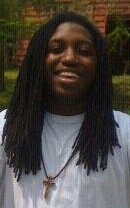
Jermain Franklin
Mentor: Dr. Francisco Hung
Hi, my name is Jermain. I have just finished getting my associates degree and will be attending LSU for the fall semester in pursuit of an electrical engineers degree. I enjoy family time, math, bowling, and playing chess. Abstract problem solving has always been interesting to me, hence the decision to become an engineer.
This summer's research was focused on grasping a better understanding of the structural and dynamic properties ionic liquids inside of nanopores (titania oxide). To perform this task we used molecular dynamic simulations and Newton's law of motion. A better understanding of these ionic liquids have the potential to optimize its use in applications such as biomedical research and energy. Ionic liquids are capable of being alternatives for electrolytes in electrochemical double layer capacitors and dye-sensitized solar cells.
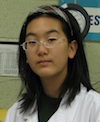
Lisa Kam
Mentor: Dr. Les Butler
Hi! My name is Lisa Kam, and I am a rising Baton Rouge Magnet high student. I plan to major in the Biochemistry field and am interested in science because of its dynamic nature. It gives me a thrill to know that there are still many future discoveries that lie in wait, many new branches to explore! Throughout this summer, I hope to learn computer programming and apply this technique with ease. My hobbies include playing the piano, drawing cartoons, and writing stories.
Spherical Harmonic functions were applied to map out 3D gunpowder pellets in a slice of a bullet. Modules that generated these objects were written in Mathematica language from E.J. Garboczi's FORTRAN code. Several components, such as center of mass, moment of inertia, and alm coefficients, were also calculated in order to achieve this goal. My responsibility in this research composed mostly of coding (e.g. center of mass finder) and deciphering the FORTRAN code.
This research is highly valuable for its contribution to visualization. 3D tomography, for example, is a common tool utilized in many areas from simple surgery to cross-sections of rocks.
My mentor, Dr. Butler, can use this project to expand on his current research: investigating how effectively flame retardants handle high temperatures. As flame retardants decrease over time, this deterioration can be followed by recreating the retardant in 3D.
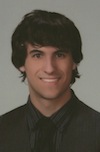
Evan Plunkett
Mentor: Dr. John DiTusa
My name is Evan Plunkett and I am a current Junior Applied Physics/Mathematics dual major at Rensselaer Polytechnic Institute. My passion lies in exploring the properties and associated physical principles of materials. My hobbies include participation in theatre, hiking, and knitting. My favorite tv show is, of course, Doctor Who.
My research was exploring the effects of doping in certain crystal structures, and then looking for changes in those structures magnetic properties. I focused on the two systems, one being Ba2CuGe2O7, the other RuGe with Cobalt doping at the Ruthenium site. Both of these structures exhibit a noncentrosymmetric crystal structure, which is to say that there is no series of rotations and translations that would allow us to map the reflection of the crystal back on to itself. This research falls in the larger context of Dr. DiTusa's lab which focuses on the magnetic and electron transport properties of noncentrosymmetric metals and half‐metals. There are several systems currently being studied for their properties, mostly of the B20 structure of which RuGe is one example. In general this research provides insight into potential technologies for spin‐based computing. This style of computing is one of the prominent potential replacements for conventional M.O.S.F.E.T. devices. This technology would require a high temperature magnetic semiconductor, of which there are none that are readily apparent. By seeking to understand more about the magnetic structuring of materials, we could uncover potential new materials that would be candidates for this kind of technological innovation.
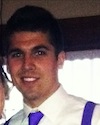
Brian Sayre
Mentor: Dr. Les Butler
Hello, I am Brian Sayre. I am a rising senior at Muskingum University, where I am majoring in Engineering Science with a minor in Chemistry. I became interested in engineering because I have always loved finding creative and sustainable solutions to problems. My hobbies are playing ice hockey, golf and fishing.
This summer, I was writing code in Mathematica to model particles in tomography data sets in 3-D. Seeing the particles in 3-D can give researchers valuable information as to how the particles within a sample fit together. Other information that was gathered from the code included moment of inertia. The moment of inertia is the measurement of how easy, or hard, it is to rotate an object about a certain rotational axis. In our research, however, it was used to determine if two particles, from two different tomography data sets of the same object, are the same.
Louisiana Tech University
Benjamin Beach
Mentor: Dr. Pedro Derosa
Dr. Ramu Ramachandran
Hello! My name is Benjamin Beach and I will be starting my junior year at Louisiana Tech University. I am majoring in Mathematics and Physics with minors in computer science and electrical engineering. My interest in math started at a young age, and my interest in computer science started with math-based programming. My hobbies include ping-pong, dodgeball, and video games.
I have been exploring the effect of spin on the conductive properties of thiophene metalla(bisdicarbollide) polymers. These dicarbollide cages have shown very good chemical stabilities and very interesting electromagnetic properties, and are currently being explored for a variety of applications as redox catalysts. The goal of the project is to see if the cages may be useful in spintronic devices, which focus on making use of the spin of electrons to encode and process data. These devices may become useful for making smaller, faster computers in the future.
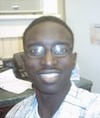
John Bell
Mentor: Dr. Tom Bishop
My name is John Bell. I am currently attending Southern University at Shreveport majoring in Computer Science with a minor in Chemistry. I have always been interested in computers and they make our lives easier. I intended to continue research in this field and continue on to the doctorate level. I enjoy video games, math, playing chess and board games.
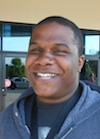
Trenton Ford
Mentor: Dr. Pedro Derosa
Dr. Naidu Seetala
Dr. Upali Siriwardane
My name is Trenton Ford, I am a Computer Science student at Baton Rouge Community College in my second year. I have been interested in the field of Computer Science since childhood and plan to pursue education in this field through to the doctorate level. I enjoy reading, playing games, and learning new things.
My research this summer focused on the categorization of nanoparticle catalysts. When characterizing a catalyst the objective is to determine the specific properties of the catalyst that may contribute to the rate of reaction or the longevity of the catalyst itself. During the summer we focused mostly on magnetic properties, thermal properties, and surface structure. The catalysts used were intended to be used in a syn-gas (H2+CO) conversion reaction. The reaction’s purpose is to produce hydrocarbons which, depending on length, can be used as fuels and lubricants. The nanoparticles are placed on small alumina granules using multiple methods. The catalysts that were used specifically were Co, Cu, Fe, and Co/Fe in various percentages. The potential of research such as this is the versatility of being able to synthesize hydrocarbon fuels without relying on fossil sources.

Tosin Oyeleke
Mentor: Dr. Daniela Mainardi
Hi, my name is Tosin Oyeleke. I attend the University of Maryland Baltimore County. I am a senior undergraduate studying chemical engineering. My interest for chemical engineering was sparked when I was in high school. I loved chemistry, physics and mathematics; and chemical engineering was able to tie all these subjects into one major. My hobbies include portrait drawing, watching the news and watching television series!!!
The Mainardi Lab has developed a systematic approach to determine the effects of catalyst in Fischer Tropsch Reactions on a nanoscale level. Fischer Tropsch synthesis, a highly-promising, developing option for clean energy production, is used for the production of liquid hydrocarbons from synthesis gas (H2 and CO). Ranging from environmentally-sound production of chemicals from biomass to sustainable production of fuel from coal and natural gas, FTS holds a huge future outlook. Of particular importance are the gas-to-liquid processes that are being developed and commercialized as part of a new world-wide industry engaged in converting remotely-located, underutilized or flared natural gas to a premium, sulfur-free diesel fuel. Despite being a traditional manufacturing technology since 1926, the complex chemistry of the FT synthesis, it is not fully understood. Effective catalysts commonly used for the production of hydrocarbons are Co, Fe, Ni and Ru transition metals.
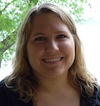
Cheryl Salmonson
Mentor:Dr. Ramu Ramachandran
Dr. Collin Wick
My name is Cheryl, I am in the dual degree program at the University of Wisconsin-Eau Claire, UWEC, where I am earning a physics degree, math and chemistry minors, and then following up with a chemical engineering degree from the University of Wisconsin-Madison. I have completed my third and final year at UWEC and will be going to UW-Madison next semester, I am looking forward to it. When I am not in class, I like to hang out with friends and travel. During the winter, I play pick-up hockey games and snowboard, and hang out on the lake, wakeboarding and jet skiing during the summer. This is my first REU and I am very excited.
Metal oxides have been found to be promising electrode materials for Li-ion batteries, providing higher capacities than standard graphite anodes.1, 2 First principles computational studies were used to understand the molecular mechanism of lithium intercalation in crystalline bulk RuO2. The calculated discharge curves for lithium in RuO2 lattice showed qualitative agreement with experimental results for RuO2 nanoplates. Our molecular level analysis showed that lithium proceeded via an intercalation mechanism until a 1:1 Li:Ru ratio, followed by a phase transition to a new tetragonal structure that accommodates higher lithium content, resulting ultimately in a recyclable Li:Ru ratio of 3:1. This new structure appeared stable throughout subsequent charging and discharging with lithium, giving different voltages, in agreement with experiments. Having validated this approach, we also studied MnO2 and SnO2 in a similar manner, as part of ongoing work to understand the suitability of different metal oxides for battery anode materials.
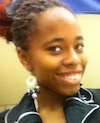
Dyamond Williams
Mentor: Dr. Erica Murray
Dr. Weizhong Dai
Hello, I am Dyamond Williams, labeled as a sophomore at Southern University at Shreveport. My major is Computer Science and I became interested in it because as a freshman in high school I was enrolled in the Computer Science Magnet Program and I enjoyed what I was doing in the classes. My hobbies are texting, being on the computer and sometimes playing basketball in my free time. This is my first REU and I am very excited.
NOx exhaust gas sensors play a critical role in monitoring diesel emissions and communicating with the vehicle diagnostic system to regulate engine operation. Sensors with greater sensitivity and accuracy are necessary to further reduce air pollution and satisfy future emission requirements. Y-stabilized ZrO2 (YSZ) is commonly used as the sensor electrolyte given its tolerance for the harsh exhaust gas environment. Recent research indicates the microstructure of YSZ plays a role in NOx sensing, as sensors with porous versus dense YSZ demonstrate greater sensitivity to NOx under certain operating conditions. This summer my research involved studying the porosity of YSZ by analyzing the effect of fabrication temperature and time on the electrolyte microstructure. The role my work plays in the main picture is it will provided an understanding of how the amount of porosity affects NOx performance, which will provide useful information for optimizing NOx sensor design. The reason this research is relevant to the audience is because porous YSZ based NOx sensors promise to provide more sensitive monitoring capabilities for vehicle exhaust systems.
Southern University

Zakee Ahmand
Mentor: Dr. Guoqiang Li
Hi, my name is Zakee, I am currently a sophomore at Frostburg State University. I am currently pursuing a degree Mechanical Engineering. I chose this major due to my interest in problem solving and the creation of everyday things. I am 19 and I enjoy sleeping and staying active.
This summer I worked in a lab constructing fabric enclosed composites. The composites I created were induced with Shape Memory Polymer fibers, Kevlar threaded fibers, Glass fibers and Carbon fibers. The main topic of my research was Shape Memory Polymers (SMP) and the significance of these materials. SMP are smart materials that are self-healing and have the ability to return to their original shape from their deformed shape when an external trigger, such as UV exposure, triggers the polymer. This is an important topic for instance, if a plane develops a micro-crack inside the engine during a flight the SMP will be able to fix the crack before a more serious problem occurs such as the plane exploding or crashing.

Jasmine Jones
Mentor: Dr. Amitava Jana
My name is Jasmine Jones. I am in the 3+2 dual engineering degree program at Xavier University of Louisiana. I have completed three years at Xavier University of Louisiana for my Chemistry degree with a minor in physics and mathematics. In the fall of 2013, I will attend Louisiana State University to finish up my last two years of my Chemical Engineering degree. This is my fourth REU program. I am extremely excited about this research opportunity because I feel like it will better prepare me for graduate school. My hobbies include cooking, fishing, watching Scandal, reading, and traveling.
The purpose of my research was to make the execution of a code more efficient so as to be able to handle the larger atomistic configurations (thousands - millions of atoms) that are typical of large-scale molecular dynamics simulations. This is important to my faculty member because molecular dynamics and visualization of thermal barrier coatings, and my research comes into play because the atomistic configurations are needed from the configuration are visualized to identify the processes corresponding to the numerical results of the simulation.
Lauren Norris
Mentor: Dr. G.L. Zhao
Hello! My name Is Lauren. I am originally from California but am currently a Junior at Gordon College in Wenham Massachusetts. I am a Physics major with a concentration in engineering and a minor in Business Management. I chose physics because I enjoy the practical application of it. After I graduate I plan on going onto graduate school. I enjoy traveling and visiting new places. I am excited for this experience and can't wait for this summer in Baton Rouge.
This summer I researched the electromagnetic absorption of carbon nanotubes. We made 2 and 3mm waveguide and 2 and 3mm coaxial samples with varying outer diameters of CNTs, <8nm, 20-30nm and 30-50nm and different weight percentages from 0.1-10%wt. We then used a PNA to analyze the transmission and reflection with a frequency from 0.1 to 40 GHz, which gave us the absorption of the samples. CNTs have the properties that could make them a good lightweight alternative to absorbers used today which are mostly metal. Metals have a high density, corrode and are rigid. CNTs on the other hand have a low density, are flexible and environmentally friendly. Absorbers could be useful in areas such as national defense, human health, and the normal operation of machines. We found that the 20-30nm and 30-50nm CNT samples with the higher weight percent had the best absorption. My professor is also looking at other types of CNTs, carbon fibers and graphite to find the best option for a lightweight absorber.
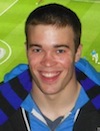
Logan Pyle
Mentor: Dr. Laurence Henry
Hello! My name is Logan Pyle and I will be a junior in Chemical Engineering at Kansas State University next fall. In high school I enjoyed chemistry and I have always wanted to be an engineer, so I combined them to find Chemical Engineering. I have had no complaints so far and plan on graduating as a CHEM-E in May 2015. In my spare time, I like to say active (running and sports), travel (I am returning from studying abroad in Spring 2013) and hanging out with people. I am excited to get to work and contribute in any way I can while enjoying my summer in Baton Rouge.
My 2013 summer REU project was another progressive step towards a proposal Dr. Henry has been forming. My project involved the connection between ultraviolet radiation (UVR) and a specific Manganite series: the Lanthanum Manganite series doped with Strontium and/or Calcium. My project came into existence because of work done by previous REU students and current students under Dr. Henry's direction. The previous two REU students performed synthesis experiments to form a specific doped Lanthanum Manganite, while current students from the Physics department at Southern University are studying ultraviolet radiation for the MARS LIFE project. My job this summer was to conduct a search for previous scientific articles using mainly the Internet and scientific databases involving both topics while gathering a plethora of background information on both topics. Lanthanum Manganites and their properties that will be studied under ultraviolet radiation in our future experiment show potential uses in Solar Energy Technology, Fuel Cell Technology and Interstellar Propulsion Devices and Systems.
Isaac Saliev
Mentor: Dr. Diola Bagayoko
Hello! My name is Azizjon, (pronounced as Ah-zeez-John) ;) I'm a rising junior at Binghamton University, New York. My major is Electrical Engineering, and I’m planning to pursue Math as a minor. My greatest passion about my major is getting as much information about Nanoscale Engineering (especially fabrication of Semiconductor Devices) as possible. I travel a lot, and I really love it. Besides traveling, I like playing soccer barefoot, taking pictures of nature and city architectures, and listening to a new music that I liked most several hundred times until it starts to annoy me.
The main purpose of my research was calculating precise band gap, density of states, and effective masses for zincblende AlP using Density Function Theory (DFT) and Local Density Approximation (LDA) enhanced by Bagayoko-Zhao-Williams and Ekuma-Franklin (BZW-EF) method. Calculating correct band gap widths for semiconductor materials and determining their optical and structural properties are crucial in manufacturing variety of semiconductor and optoelectronic devices. The common problem arises when many researchers and scientists try to come up with their own version of calculations, and hence different band gaps. For example, during literature review, we found band gaps for AlP from different sources ranging from 1.71 to 3.2 eV despite the experimental data showing band gap width of 2.52 eV. Our ab-initio BZW-EF calculation, on the other hand, yielded the result of 2.56 which is in excellent agreement with experiment.
Tulane University
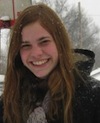
Christa Cook
Mentor: Dr. Hank Ashbaugh
Hello, my name is Christa Cook and I am from Dallas, Texas. I am an incoming junior at LSU in civil engineering. I decided civil because I've always been interested in large, eccentric structures and it is my hope to be apart of their construction one day. LA-SiGMA will be my first research experience and I am very much looking forward to it!
This summer, I worked with Dr. Hank Ashbaugh and another undergraduate student, Tuan Tran. Tuan and I analyzed varied concentrations of ethylammonium nitrate (EAN) and water. EAN is a protic ionic liquid, which is classified as a surfactant; a surfactant decreases the surface tension of a liquid, making oil more soluble in water and therefore easier to clean up. Put simple, a surfactant behaves like soap and dissolves oil. We choose to study protic ionic liquids because they are easier to make and are greener alternative to other surfactants.
Tuan and I analyzed the behavior of numerous EAN concentrations by running molecular dynamic simulations on a computer program called Gromacs, producing densities and radial distribution functions (RDFs). By changing the concentrations of EAN and water, we can paint a picture of how the overall molecular structure changes. Other researchers have analyzed the same EAN concentrations in the recent past using experimental x-ray diffraction, also producing densities and RDFs. We then compared our computer generated densities and RDFs to the experimental densities and RDFs to verify our model was in fact correct. Since the densities and RDFs matched, future researchers can use our computer program to run simulations of different concentrations without performing the physical x-ray diffraction experiment, saving time and money.

James Schwabacher
Mentor: Dr. Scott Grayson
Hi, I'm James and I am a rising junior at American University majoring in Chemistry. I realized that I wanted to pursue a major in chemistry when I was enrolled in AP Chemistry in high school; the course was a rewarding challenge. I spent this past year synthesizing antimicrobial and antiviral compounds in an organic laboratory. I greatly enjoy working in a lab and plan to blaze a career in research. Outside of the lab, I spend my time cycling, reading, and discovering new foods.
My research performed this summer sought to synthesize novel macromonomers. These novel macromonomers will theoretically allow for the creation of hyperfunctional polymers. Polymers can be utilized as backbones within globular dendrimers to increase the radius. Increasing the radius increases the overall surface area of the dendrimers, thus increasing the void volume within the molecule. Hence, larger dendrimers of a higher drug payload can be created using novel macromonomers. In Dr. Grayson's group, dendrimers and other polymers are synthesized using divergent mechanisms. Dr. Grayson's research seeks to apply dendrimers for practical applications, focusing on transdermal drug delivery and tumor targeting. As a whole, chemists are researching various methods of dendrimer synthesis in search of optimized reactions. Interdisciplinary research focuses on determining the cytotoxicity and biocompatibility of dendrimers. Furthermore, other research indicates wide-ranging possible uses for dendrimers, from acting as drugs and tissue scaffolds to forming new materials and nanoparticles. My work this summer assisted Dr. Grayson in researching dendrimer synthesis methods.

Daniel Sun
Mentor: Dr. Noshir Pesika
Hi, I'm Daniel Sun. I am a rising junior at Washington University in St. Louis. I am a chemical engineer and a math double major. I picked chemical engineering because my high school counselor looked at my transcript senior year and said, "This screams chemical engineering" and so I went with it. The math major tagged along because I couldn't get enough of math. In my free time, I enjoy exercising, reading books, and writing letters.
The goal of the research is to create carbon nanotubes. We hope to implement carbon nanotubes in electric double layer capacitors, also known as supercapacitors. Current supercapacitors are made with porous carbon, so replacing them with carbon nanotubes would multiply the effectiveness of the supercapacitor because of the carbon nanotubes’ high surface area. Creating better supercapacitors could lead to the development of large hybrid vehicles or improve various alternative energy technologies. Implementing carbon nanotubes in supercapacitors requires that they be grown vertically aligned, thin, and in high concentration. Our current research is to grow carbon nanotubes in that fashion, focusing on controlling one characteristic at a time.
Catherine Tucker
Mentor: Dr. Anne Robinson
Hi, my name is Catherine. I am a rising junior studying Cell & Molecular Biology and Spanish at Tulane University. My passion for biology was initiated in high school by my amazing introductory biology teacher; I have continued to pursue my interest in biology through research and study. Outside of classes and the lab, I enjoy running, swimming, and reading. I look forward to meeting everyone, and participating in this summer research experience!
The goal of my summer research project was to investigate the tendency of single amino acids to aggregate and whether or not these aggregates exhibit a cytotoxic effect in vitro. Recent publications led to the hypothesis that hydrophobic amino acids form aggregates in solution while hydrophilic amino acids do not. Fibrillation was qualitatively analyzed using Transmission Electron Microscopy. The cytotoxic effects of phenylalanine, a hydrophobic amino acid, on CHO cells and SH-SY5Y cells were studied as well. Each trial consisted of a 6-day period of qualitative and quantitative analysis. Live cell counts and percent viability data were collected using a hemocytometer. We found that hydrophobic amino acids do aggregate in solution, while alanine does not. Additionally, we found that phenylalanine may exhibit cytotoxic effects- cell growth was inhibited at high concentrations of phenylalanine. Future projects include conformation of hydrophobic amino acid fibrillation via CD analysis or ThT assays, additional cytotoxicity experiments, and investigation of the effect phenylalanine has on tau protein. This project in conjunction with the combined projects of the lab will further an understanding of tau protein properties and interactions, with the ultimate goal of treating neurodegenerative disease such as Alzheimer's.
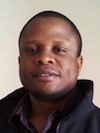
Sidney Ugwu
Mentor: Dr. Zhiqiang Mao
Hello my name is Sidney, I am a Physics Major and currently applying to a masters degree program in Petroleum Geoscience at the University of Texas at Arlington this fall. I gained interest in the Geoscience field seeing the application of physics to geological structures. I would love to explore more in the oil and gas sectors using my knowledge of computer software in researches. My hobbies are playing tennis, and watching movies.
My research was based on the layered perovskite material Sr2RuO4. This compound containing mixture of RuO2 (Ruthenium oxide) powder, SrCO3 (Strontium carbonate) powder in the right proportion chemically bonds to form the perovskite Sr2RuO4. Sr2RuO4 is a known superconductor, meaning it can conduct electricity without resistance below a certain critical temperature. However, all known superconductors have low critical temperatures relative to room temperature, usually at least 100 K below room temperature. Sr2RuO4 also has a low critical temperature, but it is known to exhibit a unique spin-triplet pairing of superconductivity, as opposed to spin-singlet pairing that other superconductor’s exhibit. The reason for this is not clear, but it is thought to be related to the magnetic properties of the material. We study Mn- and Co-doped Sr2RuO4 intensively in order to clarify the magnetic properties of the material. By understanding the fundamental properties of Sr2RuO4, we can better understand the fundamental properties necessary for superconductivity and help push superconductor technology toward a point where it is useful in common applications. This can lead to huge breakthrough in computer, transportation, and power transmission technology applications.
University of New Orleans
Victoria Bishop
Mentor: Dr. Steve Rick
Hi, I'm Victoria Bishop but I go by Tori. I am going to be a senior at Fort Lewis College in beautiful Durango, Colorado. I've always really enjoyed mathematics and design, so study generally engineering with an emphasis on mechanical and material science. My hobbies include, dance snowboarding, traveling, and anything outdoors.
Ethylene carbonate (EC) is a polar, aprotic liquid and a good solvent for ions, used in lithium batteries. Molecular dynamics computer simulations are used to investigate the thermodynamic and structural properties of ions in an EC solution. The Lennard-Jones parameters (ϵ and σ) for the ions are optimized to reproduce experimental solvation free energies. Using the optimized parameters, the solvation structure of the ions is determined. Free energy and structural data indicate that ethylene carbonate molecules have stronger direct interactions with cations opposed to anions. This will ultimately be useful in developing materials for energy storage like carbon Nano tubes and super capacitors.
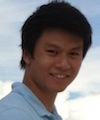
Phillip Dang
Mentor: Dr. Gabriel Caruntu
Hi, my name is Phillip, and I am a freshman at the University of Maryland Baltimore County majoring in Physics and Mathematics. I became interested in physics after taking my first course in high school and finding it to be the perfect application of mathematics. Since then, I have become much more interested in learning about the universe and exploring the many fields of physics I have not yet learned about. In my free time, I enjoy working out, sparring, and playing video games.
My mentor Dr. Gabriel Caruntu's lab specializes in the fabrication, characterization, and application of nanoscale metals and metal oxides. My research, in particular, deals with the doping of titanium dioxide with different metals in different amounts. Titanium dioxide is a known photocatalyst under ultraviolet light and is, thus, added to paints, textiles, glasses, tiles, sunscreens, and other products. Doping titanium dioxide with metals has proven to create a photocatalyst under visible light as well as ultraviolet light. Through creation and characterization of several metal-doped titanium dioxide samples, I hope to determine which concentrations of which metals are the most effective photocatalysts under visible and ultraviolet light and potentially improve the products that titanium dioxide is used in.

Daniel Livingston
Mentor: Dr. Lezsek Malkinski
Hello! My name is Daniel Livingston, and I am a rising senior at New Mexico State University. I am majoring in physics and applied mathematics, and minoring in philosophy. These three fields, while seemingly dissonant, excite me because they all – in their own way – attempt to fundamentally understand the cosmos and our place within it. I plan on pursuing a Ph.D in theoretical physics after graduation. I enjoy playing the guitar, computer programming, and doing graphic design; and I'm absolutely enthralled with physics, philosophy, technology (esp. nanotechnology), literature, art, and music from Chopin to Bob Dylan to Radiohead.
My mentor is interested in using magnetic piezoelectric nanoparticles to control the functions of cells; specifically, mammalian cells. From this research, new insights into bio-molecular processes and their effects on physiological cell functions will be gained. In the coming bio- and nano-technological wave, this research may prove instrumental. As the cellular functions are manipulated via magnetic nano particles, the crux of the manipulation lies in the electric field controlling them. I set up electrostatic simulations of two electrodes, and the properties of their generated electric field. This will allow my mentor more knowledge on the best construction for the real-world electrodes, and of the electrostatic properties he can expect.
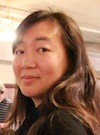
Alice Mao
Mentor: Dr. Leonard Spinu
Hi, I am Alice Mao, a freshman at USC. I am currently an undeclared major, though I am interested in the sciences. I originally took an interest in physics and chemistry when I completed an independent research project in high school, dealing with lithium ion batteries and learning more about the concepts behind the mechanics of work and energy. My hobby is reading.
In this summer program my research topic was in the field of Material Science - Applied Physics, and it was related with the fabrication and magnetic characterization of nanostructure materials. In particular, I worked on the fabrication of Nickel nanowires (NWs) by the electrodeposition technique. To control the magnetic response of these Ni NWs, different lengths of NWs were fabricated. It is worth to mention that these NWs were grown inside of the pores (250 nm) of the commercial Anodic Aluminum Oxide templates (AAO, membrane thickness of 60 μm). With the aim of being used in microwave devices, the manipulation of these nanowires was part of my research, which it was focused in embedding them into electrically active polymer matrixes (piezoelectric). The central hypothesis of this project is on the idea that magnetic nanowires embedded into piezoelectric matrixes can be helping in to tune the magnetic response through the application of electric field. Therefore, in analogy with tuning a radio-station in different dials using a knob, the microwave absorption can be tuned through applying a variable electric field. In a general point of view, through this short term research I have learned about the theoretical aspects of this fabrication technique, the ideal growth mechanisms mainly described by the Faraday law, in contrast with the real experimental difficulties, and the "for and against" of the different approaches taken in these procedures. In parallel, the magnetic characterization of these samples were conducted by Vibrating Sample magnetometry (VSM), X-band (9.9 GHz) and broadband (1-40 GHz) Ferromagnetic Resonance spectroscopy. The systematic magnetic characterization of these samples has helped us in to find the best fabrication conditions and performance for their subsequent application in microwave absorption devices, such as antennas and telecommunication. The Spin Dynamics Laboratory (SDL) is located in the Advanced Materials Research Institute (AMRI) and Department of Physics from University of New Orleans. The laboratory works in the main area of nanomagnetism with basic and applied research projects focused on nanoscale characterization of magnetic structures for nonvolatile memory applications, magnetization dynamics in nanostructured materials, and controlled spin dynamics in solid state qubits.
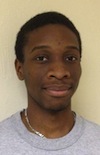
Dexter Taylor
Mentor: Dr. Steve Rick
Greetings, my name is Dexter Taylor, I am from Raleigh, North Carolina and I am an applied physics major currently studying at Morehouse College. The LA-SiGMA program absorbed my interest due to its vast concentration of material science research projects. It is an aspiration of mine to utilize my research and academic experience in material science to design sustainable shipping container homes that are environmentally admissible for our planet and economically efficient for the individuals who would occupy these abodes. My hobbies include social celebrations, video games, exercising, reading and anything else fun that does not involve me appearing before a judge.
We were investigating the thermodynamic and structural properties of an ion in an ethylene carbonate solution. This was done by using thermodynamic integration of optimized parameters ϵ (atom interaction strength) and σ (atom size relative to one another). Members of Dr. Steven Rick's Lab were permitted the results to a similar study done at Louisiana Tech. Scientist at Louisiana Tech determined that cations have a stronger interaction strength with ethylene carbonate than anions. A cation is an ion that has developed a net positive charge and an anion is an ion that has developed a net negative charge. This project’s research can be used to bridge the gap between capacitors and rechargeable lithium-ion batteries, by allowing scientist to determine good solvents for ethylene carbonate and develop more efficient super-capacitors.
Xavier University
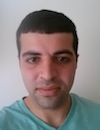
Abdulla Altikriti
Mentor: Dr. Jaya Sridhar
Hi, my name is Abdulla Altikriti, I will be a senior at Rutgers after this summer. My major is chemical engineering and I chose it because I loved math and chemistry coming out of high school. Going to New Orleans will be the first time I leave the east coast and I am very excited to see what it’s like. My favorite hobbies are soccer, basketball, traveling, and meeting new people.
Using computer software called Molecular Operating Environment (MOE), we simulated the docking of over 400 phthalimide molecules onto cyclin-dependent kinase (CDK) 2 and CDK 5 proteins. CDK's are proteins that regulate the cell cycle. Docking is the study of computationally removing the original ligand molecule within a protein and replacing it with another molecule and observe the different interactions it causes. The simulation allowed us to narrow down the list of 400 to less than 40 molecules for future chemistry lab experimentation. One or more of these 40 molecules could be a possible CDK2 and/or CDK5 inhibitor which may be able to prevent a defective cell such as a cancer cell from proliferating and increasing in numbers.
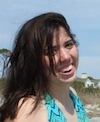
Brennan Ferguson
Mentor: Dr. Kevin Riley
Hi, I'm Brennan, and I am an upcoming junior at Alfred University in Alfred, NY. I am double majoring in chemistry and environmental studies. My interest in chemistry was sparked when my inspirational high school chemistry teacher performed the exploding gummy bear experiment, and I have always loved the environment. My hobbies include basketball, tennis, hiking, watching movies, and playing games.
The cure for cancer is one of the most daunting challenges that the scientific community faces today. One possible solution is a pharmaceutical cure that focuses on ligands, which are small molecules that bind to and activate proteins. Dr. Riley's lab uses computational methods to study the noncovalent interactions between ligand and protein to create new drugs to cure cancer. In my research I studied the liver X receptor (LXR) which is a very influential protein in the body and shows promise for treating high cholesterol and colon, pancreatic, and breast cancer. LXR has an α receptor (LXRα) and a β receptor (LXRβ) that have different ligand preferences. This summer I explored the interactions between the LXRα and LXRβ with ligands to better understand the selectivity of the binding process. A ligand that has preference for LXRβ would restrict cholesterol transport, lower cholesterol, and starve malignant cells which may help develop a pharmaceutical cure for cancer.

Lauren Luce
Mentor: Dr. Stassi DiMaggio
Hi, I'm Lauren! I'm pumped up and ready to begin this summer! I became interested in research as a career last year whenever I participated in the International Science and Eng. Fair. My teacher who helped me know longer teaches, so I've been waiting for an opportunity like this to get involved in. I'm graduating early from high school this year and will be entering Nicholls State in the fall as a sophomore in chemistry and math. I enjoy dancing, and I have some experience playing bass guitar and bassoon. If I have spare time (which is rare), I enjoy reading or making jewelry.
Poly(amidoamine) (PAMAM) dendrimers can be used as a platform for drug and gene delivery systems when conjugated to small, functional molecules. However, polydispersity in the conjugated products impedes their translation to the clinic. Because of polydispersity among populations in PAMAM dendrimers, it is necessary to conjugate them to polar ligands so that the populations may be separated using prep HPLC. 3-(4-(2-azidoethoxy)phenyl) propanoic acid, azide ligand, was synthesized using a three-step method for that purpose. Each intermediate product and the final product were characterized using, HPLC, CG/MS and NMR. G5 PAMAM dendrimers were purified using dialysis. The azide ligands were then conjugated to the purified G5 PAMAM dendrimers by EDC/NHS coupling. It was characterized using NMR, and an HPLC showed the resolving of populations. In the future, we will characterize the conjugate using MALDI-ToF and further resolve the population peaks before ultimately isolating the populations using prep-HPLC.

Gregory Salazar
Mentor: Dr. Kevin Riley
Hi guys! My name is Greg Salazar and I will be a senior at California Lutheran University this upcoming year. I am majoring in chemistry with minors in math and physics. I study these three disciplines because they are the most interesting ways to describe how the world works and will be very useful tools for my intellectual toolbox. My ideal career would involve designing cool new materials that could be very useful to a lot of people. In my spare time, I enjoy throwing a football around outside, playing basketball, writing poems, looking at stars at night, tweeting, and having fun with my friends. I’m really excited to do research and looking forward to my experience here!
An effective strategy to treat tumors and cancer is by drug development. Drugs are small molecules that bind to different proteins in the body. Once these proteins are activated through binding, they induce different biological processes. One in particular is the Liver X Receptor (LXR). LXRs are responsible for exporting cholesterol out of tissue. Since some tumors are dependent on cholesterol, activation of LXR is an ideal method for treating certain types of cancer, like colon, breast, and other diseases like atherosclerosis. Unfortunately, LXR has two types, LXRα and LXRβ. Since LXRα is located in the liver, which is dependent on cholesterol for its job, activation of LXRα is not an ideal choice. This feature is important when designing an optimal drug to activate protein and not the other.
My research focuses on computationally investigating the different types of forces between the drug and the protein. My mentor, Dr. Kevin Riley, researches non-covalent interactions, meaning different atoms that are not sharing electrons. His expertise has helped us calculate how these drugs bind to proteins. I studied how the interactions play a role in protein-drug binding. I accomplished this through simulating the molecular movement (molecular dynamics), studying the 3D shape of the protein (docking), and mutated protein atoms to see which ones played a strong role in binding (glycine scanning).
-
-
Summer 2012
-
Louisiana State University
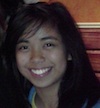
Samantha Fadrigalan
Mentor: Dr. Juana Moreno
Hi, I am Sam. I am an incoming senior at Louisiana School for Math, Science, and the Arts. My senior year will be filled of math, programming, and physics classes. Hopefully, the opportunity to be here would give me a better idea of what I should major in college. Some of my hobbies include: reading, frisbee, basketball, and playing the guitar.
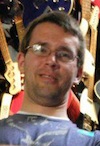
Nathan Keilbart
Mentor: Dr. Phil Sprunger
My name is Nathan and I will be a senior studying Mechanical Engineering at Brigham Young University-Idaho in the fall of 2012. I became interested in engineering when I attended a career fair put on for high school students. I picked up the pamphlet for engineering and I remember reading a phrase that said something along the lines of how engineers are able to change the world. Once I read that I was sure it was the career path for me. Some of my hobbies include dancing, video games, running, and the occasional book.
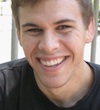
Chris Kieren
Mentor: Dr. John DiTusa
Hi, my name is Chris. I am currently a sophomore pursuing an Electrical Engineering Major at BRCC. I have always been curious about the world around us and I plan to pursue a career that fosters creativity and problem solving. I have two adorable daughters and a beautiful wife that I love spending time with. I also enjoy competing in Jiu-Jitsu, golf, and cycling.
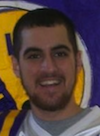
Donald Pleshinger
Mentor: Dr. Les Butler
Hi, my name is DJ and I will be a senior this coming year at Ohio Northern University where I am majoring in physics and applied mathematics. I have always been interested in math and why the world acts and works the way it does, so studying physics was an easy choice for me entering college. In my spare time I enjoy being active, whether it be running or playing sports, as well as watching movies.
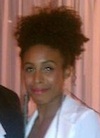
Alys Reed
Mentor: Dr. Ram Devireddy
My name is Alys, and I am a senior majoring in Biological Engineering at Louisiana State University. I became interested in Biological Engineering because I love learning new things about the world around me and using analytical thinking to solve problems. I experienced working in the food industry at a cheese manufacturing company, Leprino Foods, but I want to broaden my horizons and delve into the other aspects of my major. Nowadays, I'm usually working or studying, but in my free time, I enjoy spending time with my family and friends, doing yoga, and shopping.

Madeline Reed
Mentor: Dr. Dorel Moldovan
Hi, I'm Madeline! In the fall I will be a senior chemistry major at Francis Marion University in Florence, South Carolina. My passion for chemistry was ignited during an introductory chemistry course in high school. I am absolutely enthralled by all of the different elements, their properties, and how they are crucial for survival because they form our world. I am particularly interested in medicinal chemistry and chemical engineering. After I graduate from FMU I plan to attend graduate school. Some of my hobbies include: yoga, tennis, reading, hanging out with friends and family, meeting new people, and learning new things.
Louisiana Tech University
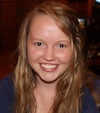
Victoria Bamburg
Mentor: Dr. Tom Bishop
My name is Torie; I am a freshman at Louisiana Tech University. I just graduated from The Louisiana School for Math, Science, and the Arts. My major is biomedical engineering and I because interested in it primarily because I love biology. However I like how biomedical engineering combines biology with problem solving and critical thinking. I first became interested in biomedical engineering last summer while doing research in biology. I really enjoyed the mechanical side of biology and instrumentation. Some of my hobbies include piano, skating, swimming, and reading.

Regina Blackman
Mentor: Dr. Erica Murray
I am Regina, a Junior at Francis Marion University. My major is Chemistry and I have always had an interest in it. I love to be in a lab working on something. Outside of Chemistry, my hobbies are music and gaming. I am a trumpet player and got into gaming when I would hang out with the other trumpets in high school. Music has always been a passion of mine, and the gaming just kind of stuck with me.

Ronald Brown
Mentor: Dr. Tom Bishop
Hello. I am Rocky, and I am a rising senior in physics from Radford university near Blacksburg, Virginia. I am currently pursuing a Physics degree with a minor in Astronomy. After I finish my degree, I plan on pursuing a degree in Aerospace Engineering. I'm not entirely positive as to what caught my attention in physics, but I suppose it was the close correlation between physics and the majority of my previous engineering classes that prompted me to choose this academic path. Also, since I have always enjoyed astronomy, it gave me some motivation to pick a field that was closely related to my interests. There are multiple things that I enjoying doing on the extracurricular scale, and they include-but are not limited to- gaming, hunting, reading, watching movies, and hanging out with my friends and family. I am glad for this opportunity to research new things, and I hope that by participating in this REU I will better myself as a student.
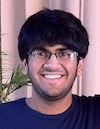
Aditya Das
Mentors: Dr. Collin Wick and Dr. Ramu Ramachandran
Hi, my name is Aditya and I am a rising junior at Carnegie Mellon University. I am majoring in physics with minors in biology and chemistry. I wish to pursue a medical degree after graduation because the complexities of the human body intrigue me. Furthermore, I chose physics as my major because I believe it lays a foundation for most of the other sciences and develops problem-solving skills that can be useful in any profession. My hobbies include driving, traveling, and playing baseball and football.
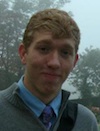
David Howe
Mentor: Dr. Weizhong Dai
Hey there, my name is David Howe and I am rising junior physics student at the University of Notre Dame with an engineering concentration. I am interested in physics because of its unique capability to dramatically alter both how we as a civilization conceptualize the world around us and how we interact with it on fundamental levels. In my free time I compete with the Notre Dame Water Polo team and compete with an amateur boxing program, as well as enjoy myself hip-hop dancing, writing poetry, and playing frisbee with my friends. I call Roswell, GA my home, but I grew up in Pittsfield, MA. I have worked for the past semester in the Nuclear Structure Laboratory at UND with Prof. Philippe Collon, and I recently completed fabrication of a Bragg Curve Detector, which has since been integrated into the larger detector there.
Southern University
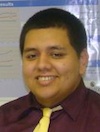
Juan Arredondo
Mentor: Dr. G. L. Zhao

Matthew Kornfield
Mentor: Dr. Laurence Henry
Hello, I am Matt. I am incoming sophomore at Georgetown University. I am majoring in physics, which really caught my interest towards the end of high school and still hasn't let go. I just loved the idea that the world has its own set of languages, and that physics is one of those languages. My hobbies are reading, i.e. some magazines like National Geographic, or fantasy and science fiction novels, as well as going out on the water, either in a sailboat or powerboat. I also love to travel, and try to make use of my understanding of Spanish whenever possible.
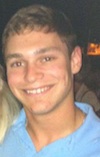
Cole Vanderlick
Mentor: Dr. Amitava Jana
My name is Cole Vanderlick. I just finished my sophomore year at BRCC and will attend LSU in the fall. I'm majoring in Petroleum Engineering. I love this major so far, and I'm excited to see where the career will take me. I played baseball at BRCC for two years. I love sports, hanging out with friends, and having fun. I am very excited for this research program.
Tulane University
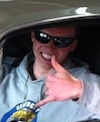
Thaddeus Howard
Mentor: Dr. Noshir Pesika
Hi, I'm Thaddeus. I'm a sophomore physics major at the University of Dallas. I have always been fascinated by learning how things work. My lifelong hobby has been working on cars. After attaining an advanced degree in mechanical engineering, I hope to work in the automotive industry as an engineer.
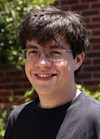
Joey McPherson
Mentor: Dr. Noshir Pesika
My name is Joey and I am a rising junior at Rhodes College in Memphis, Tennessee. I am currently majoring in Physics and minoring in Mathematics. In my free time I like to play the piano, read books, tinker with electronics, and play video games. I plan to continue on to graduate school, where I will continue to study Physics and concentrate in one of the following fields that interest me: Astro, Particle, Material, or Nuclear Physics.
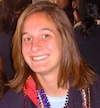
Ellie Rodebeck
Mentors: Dr. Anne Robinson and Dr. Hank Ashbaugh
I'm Ellie Rodebeck, a rising senior at Tulane University. My major is Biomedical Engineering as a pre-med and I am currently applying to medical schools. I love competing in running/cycling/triathlon races, reading, music, discovering new restaurants, and living in New Orleans! Looking forward to REU research this summer!
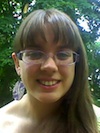
Julia Russ
Mentor: Dr. Zhiqiang Mao
My name is Julia Russ and I am a rising Junior physics major from Ithaca college in Ithaca, NY. I got into physics my first semester of college after taking a gen ed astronomy course. Although the physics course was not for science majors and didn’t go into depth mathematically, I found the conceptual physics ideas presented in the class fascinating. I continue to be drawn by the ideas presented in physics and I am in awe that these ideas actually describe the world and universe we live in.
Other than physics, I am also into cooking vegetarian food, playing badminton, swimming, hiking, trying new foods, traveling to new countries and places (my last REU was in Taiwan), sci-fi shows (especially Battlestar Balactic and Star Trek) and playing video games. I have never been to New Orleans, or anywhere in the United States west of Ohio and I am looking forward to exploring the city and its culture and trying new food.
University of New Orleans
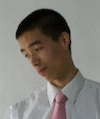
William Deng
Mentor: Dr. Gabriel Caruntu
My name is William and I am a junior at Columbia University. I am double majoring in Chemistry and Chemical Engineering. I first became attracted toward these majors in college after having wonderful, supportive professors who introduced me to something that I enjoy immensely. My hobbies include working out, playing sports, listening to music, and sleeping.
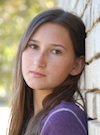
Andrea Rice
Mentor: Dr. Leonard Spinu
My name is Andrea and I'm a sophomore at Northeastern State University in Tahlequah, Oklahoma. I am double majoring in Molecular/Cellular Biology because of interest in research over the genes of fruit flies. I enjoy music, video games, writing poetry, and hunting.
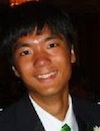
Adam Wang
Mentor: Dr. Leszek Malkinski
My name is Adam and I'm a sophomore at Brandeis University. I am planning on double majoring in physics and mathematics and would like to continue my studies through graduate school. Much of my interest for physics was generated from my first-year professors as well as my father, and there is a great overlap between the fields of physics and mathematics. In my free time I enjoy playing the cello, running, and reading.

Sheldon Williams
Mentor: Dr. David Mobley
Hi my name is Sheldon, I am currently a junior at Southern University at New Orleans. I am persuing a degree in Biology and minoring in Business Entrepreneurship. Even though I am a biology major, my main interest lies in chemistry because of the challenge that it possesses. My hobbies are socializing, researching, reading, and running track. In the future i would like to attend medical school where I will advance my knowledge in science.
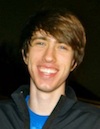
Pierce Wisdom
Mentor: Dr. Steve Rick
My name is Pierce and I am currently a rising junior at Rhodes College in Memphis, Tennessee. There I am pursuing an undergraduate degree in Physics as well as some interests in Philosophy. I became a Physics major due to a combination of my interests and the influence of two of my high school teachers. Physics is a subject that I have always enjoyed, and the prospect of discovering how things work and interact is something I find exciting. Besides my academic life, I play soccer, I box, and I play the trumpet. I plan to continue my education through graduate school, but have yet to choose a field of interest.
Xavier University
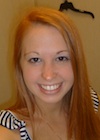
Allyssa Massie
Mentor: Dr. Galina Goloverda
Hello, I am Allyssa. I am a senior at Baker University (Kansas). My majors are chemistry and Spanish and I decided to study them both because they challenge me but are always fascinating. I enjoy long walks, yoga, watching movies, trying new foods, and spending time with my friends.

Kevin Willis
Mentor: Dr. Galina Goloverda
My name is Kevin Willis. I'm from Mandeville, LA and am in my final year at LSU studying Chemistry. My interest in sciences sparked during high school when I took biology and chemistry. After taking a great deal of courses in college, I found my interest in chemistry to grow immensely, especially in organometallics. I love that the use of four basic types of reactions has an impact on everything in life. Outside of class and lab, I like to hang out and have sophisticated debates with friends, play video games, music, meet new people, cook, explore different places and ideas, and play guitar.
-
-
Summer 2011
-
Louisiana State University 
Noah Davis
Mentor: Dr. John DiTusaMy name is Noah Davis, and I am from Abita Springs, Louisiana. I like the outdoors, video games, sports, chess, and comedy among other things. I also have a pet rat. I recently finished my third year at LSU double majoring in Physics and Chemistry. I want to study these subjects so that I can understand the world around me. I see interesting things happen every day. When I see a television showing the news or a crane working on a new building, I can’t help but think of why these things work the way they do. I recently got married and live just off campus with my wife. She is also an LSU student.
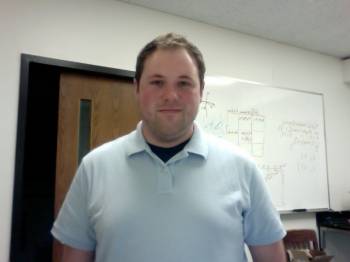
Kameron Kilchrist Mentor: Dr. Les Butler My name is Kameron Kilchrist and I am a rising junior in Biological Engineering at Louisiana State University and I plan to graduate in May 2013. I am from Lafayette, LA and attended Lafayette High school. After graduation, I plan to pursue a Ph. D. with research relating to tissue engineering. During the regular school year, I work with Dr. Daniel Hayes in the biological engineering department on osteogenic constructs for tissue engineering applications. I have broad interests in tissue engineering, electronics, and visualization techniques. This summer I am working with Dr. Les Butler on calculating surface normal vectors to mathematical reconstructions of particles imaged in 3D with computed tomography (CT) techniques and using these normals to predict a various properties about the particles with respect to time.
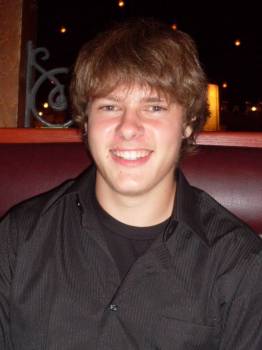
Igor Kolesnichenko Mentor: Dr. Randall Hall I'm Igor and a senior at LSU. I am a Chemistry major and I became interested in it because my parents are both chemists, so I was always in their labs watching/doing experiments. I was a gymnast all of my life, so I love to be active and do a lot of sports. I also played piano for 10 years and now play guitar.
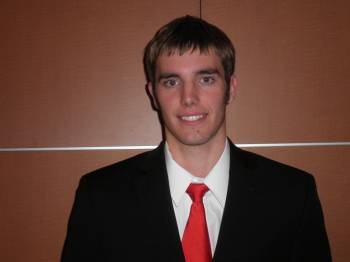
Shane Lindemann Mentor: Dr. Dorel Moldovan My name is Shane. I am going to be a sophomore at LSU this upcoming fall. My major is Physics, and I became interested in physics in high school when I took a basic physics class my junior year. My hobbies mostly include playing sports, namely basketball, soccer, and golf, but I love playing all sports every once in a while.
Hannah Manuel Mentor: Dr. Ward Plummer
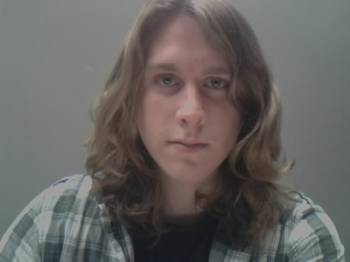
Jeff Parrozzo Mentor: Dr. Randall Hall My name is Jeff Parrozzo and I recently graduated from the Louisiana School for Math Science and the Arts in Natchitoches. This fall I will be a freshman at LSU majoring in Physics. The last research project I was involved in was my senior thesis at the Louisiana School which focused on the analysis of eclipsing binary stars. Although my interests lie primarily in astronomy and astrophysics, I am always looking to broaden my horizons and explore new areas of science. One of my favorite hobbies is antique restoration from pre-WWI rifles to vintage cars. The last two projects I worked on were restoring a Fusil Gas Mle 1874 and a 1974 Harley Davidson Sportster. I am also interested in military history and, of course, my academics.

Cade Thomasson Mentor: Dr. Randall Hall My name is Cade, I will be a freshman at LSU in the fall 2011 semester. I'm a Biological Sciences major but I'm likely to switch over to Computer Sciences. I've always had an interest in biology and computer science, with computer science becoming more prevalent recently. I enjoy programming, cooking, and fishing.
Bradley Wood Mentor: Dr. Les Butler My name is Bradley Wood, and I am currently an MA student in Philosophy. During the Summer 2011 REU, I worked with Dr. Les Butler on hydrogen absorption in metals by utilizing 3D visualization techniques. For the past three years I have been working on problems in organismal morphology and the evolution of complex biological systems. Prior to my research in biology, I did research in particle physics. My main academic interests are in the methodological practice and theoretical foundation of scientific inquiry. I intend to complete a PhD in either biological science or philosophy of science and to continue my scientific pursuits in order to answer my philosophical questions."
Louisiana Tech University
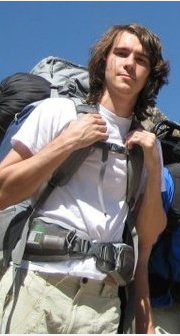
John Bordelon Mentor: Dr. Weizhong Dai My name is John Bordelon. I am going to be senior in Electrical Engineering this fall at LSU. My hobbies are video games, chess, and playing drums.

Gustavo Gutierrez Mentor: Dr. Collin Wick My name is Gustavo Gutierrez, and I am presently a Junior at Louisiana Tech University. I am majoring in Biomedical Engineering and Nanosystems Engineering and eventually hope to become an MD-PhD in the area of Biomedical Engineering. My hobbies include making programs for the parallax boe-bot, video gaming, swimming, paintball, karate, watching anime, and studying various forms of art. My goal is to become a qualified health professional so that I may help others through the development of advanced biological systems and/or artificial structures to improve the human condition.
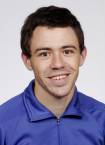
Joshua Slocum Mentor: Dr. Ramu Ramachandran Hello, my name is Josh. I am a senior Chemistry major at LouisianaTech. The areas of chemistry that interest me most are physical chemistry and quantum chemistry. I also like to run; I am on the cross-country and track teams at Louisiana Tech.
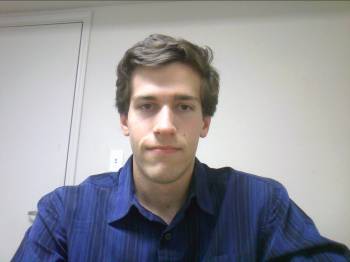
Matthew Wespetal Mentor: Dr. Daniela Mainardi I'm Matthew, a sophomore at Grove City College, near Pittsburgh, PA. I am majoring in Physics with an eye on earning a doctorate later and doing academic research. The focus on science has not cured me of my love of the arts or of my preoccupation with philosophy, so in my spare time I mostly read, think, or simply enjoy life. I speak Russian as a second language and have spent most of my life in the part of the world that speaks it. God bless!
Southern University 
Zephra Bell Mentor: Dr. G.L. Zhao My name is Zephra Bell and I am from Asheville, North Carolina. I am majoring in Physics at Southern University and A & M College. I will be graduating in December. It is my goal to be enrolled in a Bridge to the Doctorate program for the fall of 2012 to earn my Ph.D. in either materials science or medical physics. I have had numerous internships. Three of them were out of state and included programs such as the Faculty and Student Teams (FAST) program under the U.S. Department of Energy and the University of South Florida’s Physics REU. I am currently a participant in the LA-SIGMA REU in which I hope to learn more about nanomaterials. I am also a proud mother to a 3yr old son who survived three heart surgeries at two weeks old.
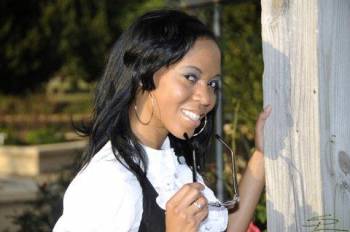
Paige Northern Mentor: Dr. Shizhong Yang I am Paige, I am a Junior at Southern University and A&M College. My major is Biology and I became interested in it due to my love for science and my passion to become an Emergency Room Physician. My hobbies are: singing, dancing, modeling, spending time with family and friends, and playing sports.
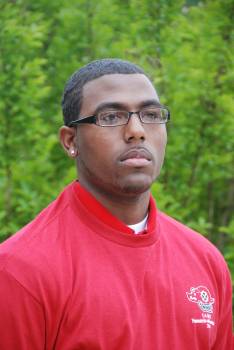
David Scott Mentor: Dr. Lawrence Henry My name is David, I am a rising Senior at Norfolk State University. I am pursuing a bachelor's degree in Electronics Engineering and at least a minor in Mathematics. I became interested in engineering because I believed it best suited my style of learning. In my spare time I enjoy playing/watching various sports.
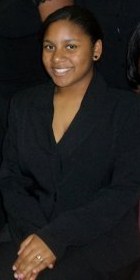
G'Nita Wright Mentor: Dr. Amitava Jana I am G'Nita. I am a sophomore at Southern University A & M College. My major is Chemistry. I became interested in chemistry after having a wonderful teacher that challenged me to learn more about how elements work in our natural lives. It has fostered throughout my matriculation participating in the Summer Bridge Institute and being a part of the LS-Lamp programs. My hobbies include reading, writing, and traveling.
Tulane University 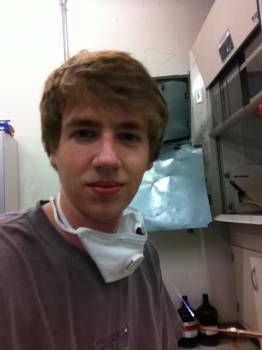
John Coody Mentor: Dr. Zhiqiang Mao Hi, my name is John, I'm a sophomore at Louisiana Tech University in Ruston, LA. I'm majoring in Physics and English due to a deep interest in various perspectives of nature and human culture. I enjoy playing musical instruments such as the electric bass and electric guitar, reading philosophy, playing table tennis and other sports, and experimenting with and implementing a variety of incendiary devices for the furthering of science, or self-preservation in remote locations.
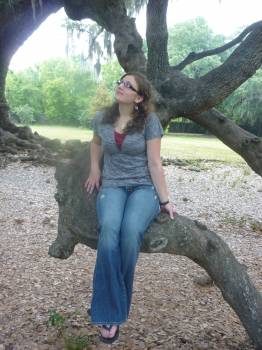
Christina Oerter Mentor: Dr. Hank Ashbaugh Hello my name is Christina and I am a junior at CU Boulder. My major is Environmental Engineering and I became interested in it because I wanted a major that combined my love of animals and the environment with my love of math. I always say I am going to save the polar bears through Calculus. My hobbies are reading, singing, painting, listening to music, and telling bad jokes.
Joshua Riggs Mentor: Dr. Lawrence Pratt Hello, I am Joshua. I am will be a junior at Louisiana Tech University in the Fall. I am majoring in Physics, and I picked it because I wanted to learn how atoms interact. My hobbies are hanging out with friends, playing basketball, reading, and participating at the Wesley Foundation on campus.
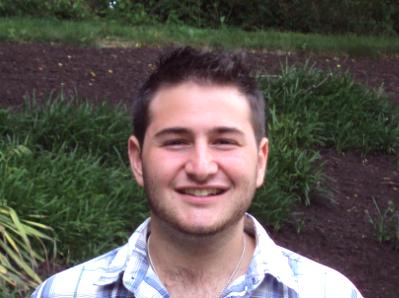
Michael Soforenko Mentor: Dr. Noshir Pesika My name is Michael, and I am a rising Senior at Tulane University. Originally from Baltimore, I am pursuing a double major in Chemical Engineering and Physics with a minor in Business Administration. My hobbies are playing tennis, longboarding, and bhangra dancing. After college, I plan to pursue a graduate degree in Materials Engineering.
University of New Orleans 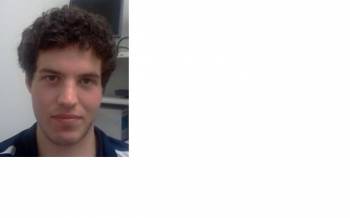
Jacob Faucheaux Mentor: Dr. Gabriel Caruntu I am Jacob. I am a senior at Louisiana Tech University. I'm a Chemistry major. My hobbies are playing basketball, tennis, and running.
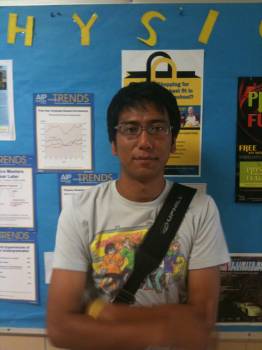
Tshering Gurung Mentor: Dr. Leonard Spinu I am Tshering. I am a senior at the University of New Orleans. My major is Civil Engineering. I am interested in design and construction of huge complicated structures. My hobbies are playing basketball, listening to music, and photography. This REU has provided a research opportunity for me to learn more about material science. The staff members are friendly and helpful. I am glad I joined the program this summer.
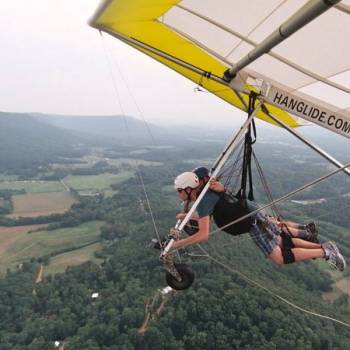
Kristofer Knittle Mentor: Dr. Leszek Malkinski Kristofer, an Electrical Engineering major at Penn State University, considers himself to be a cultured world traveler who has a passion for experiencing new foods and cultures. Outside of the academic world, Kristofer spends time in fitness, with friends and at sporting events. Before graduation he will have taken the Fundamentals Exam (FE), the first of two exams to become professionally certified in engineering.

Raphael Mariano Mentor: Dr. Steve Rick Hello, my name is Raphael. I am a senior at the University of New Orleans. I am currently majoring in all of Chemistry, Mathematics and Physics. I am particularly interested in the overlap of the fields of Physics and Chemistry. I find remarkable how things can both mesh and clash at such a minute level. I spend most of my time studying and tutoring. I am also active in school organizations, serving as a UNO Krewe Leader and a member of the Leadership Cabinet. I am currently the Vice President of the UNO Chi Alpha Christian Fellowship; and Secretary of the UNO Genshiken Anime Club. What little leisure time I have left is spent as a “geek-of-all-trades” by watching television, playing video games, reading comic books, catching up on Japanese anime, writing stories and poems, learning songs from various musicals, and spending time with friends.
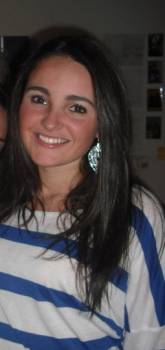
Emily Taylor Mentor: Dr. David Mobley My name is Emily, and I am a junior at Manhattan College in New York City. I am a Chemical Engineering major. I chose to study this because it incorporates the classes that I enjoyed most in high school, chemistry and math, and uses them for real life applications. Also, the versatility one can have with a chemical engineering degree in the job market makes it a great major to have. Some hobbies of mine include going to the beach all summer long, traveling with friends and family, and driving aimlessly.
Xavier University 
Tiara Adejare Mentor: Dr. Cheryl Stevens My name is Tiara; I am a sophomore at Xavier University of Louisiana. My major is Chemistry Pre- Pharmacy and I want to become a pharmacist because of the opportunity to have a personal connection with my future clients and the wide variety of opportunities that the major holds. My hobbies include shopping and trying different types of foods.
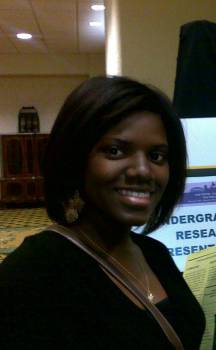
Mila'na Jones Mentor: Dr. Lamar Meda I am Mila'na. I was born and raised in Mansfield, LA. I attended high school at the Louisiana School for Math, Science, and the Arts (LSMSA) in Natchitoches, LA. I am now a sophomore at Xavier University in New Orleans where I am an (ACS Certified) Chemistry major. I became interested in chemistry when I took organic and polymer chemistry courses at LSMSA. I enjoy materials science research in particular because I want my work to be beneficial to our society and I know that my contributions, no matter how small, may help mankind in some way. My hobbies include performing research, reading, tutoring, doing volunteer work/community service, playing sports, watching television, and spending time with my friends and family.
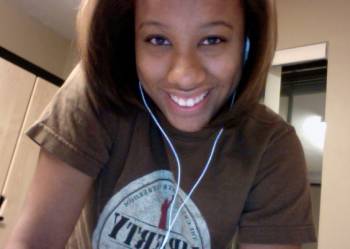
Shamarri Riddle Mentor: Dr. Lamar Meda Hello, I am Shamarri Riddle and I am a sophomore at Xavier University of Louisiana. My major is Biochemistry and I became interested in this program due to my interest in researching. My hobbies include running track, reading, and listening to music.
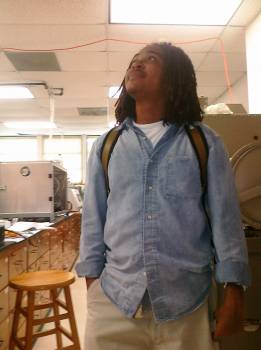
Christian White Mentor: Dr. Lamar Meda Hello, I am Christian; I am a junior at Xavier University of Louisiana. My major is Chemistry (A.C.S) and I became interested in it due to my passion for chemical synthesis. My hobbies are research, fishing, and riding 4 wheelers.

Xylona Williams Mentor: Dr. Lamar Meda My name is Xylona though most people find it much easier to call me Z. I am a sophomore at Xavier University of Louisiana. My major is Chemistry ACS and I also have a minor in Math. I became interested in chemistry when I began dealing with chemicals in high school, and I then became more interested in it once I heard about the PREM (Partners for Research and Education in Materials) program, which allows me to be hands on doing research in the lab using all sorts of different chemicals. My hobbies are dancing, modeling, and nurturing others, although, I do like to squeeze in a little bit of shopping every now and then.
-
-